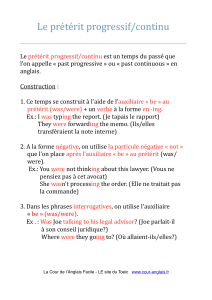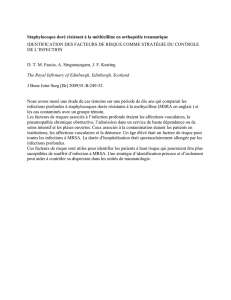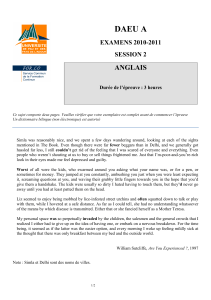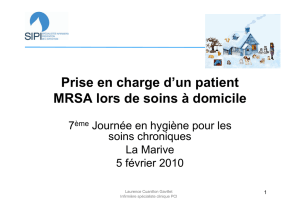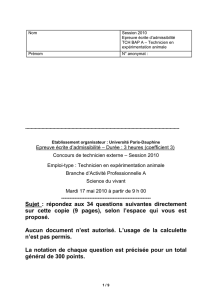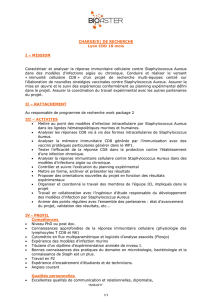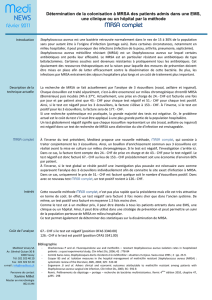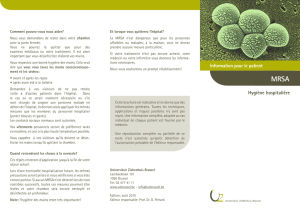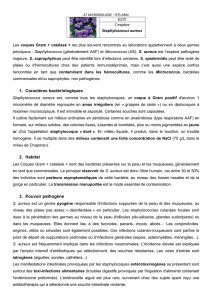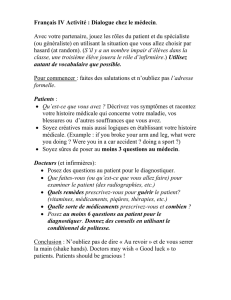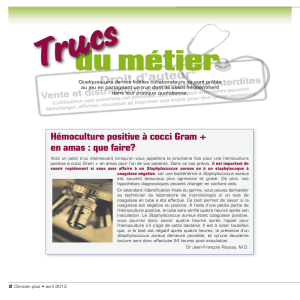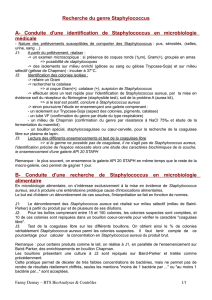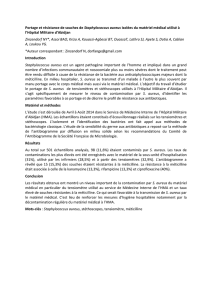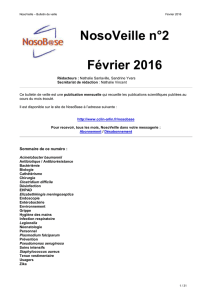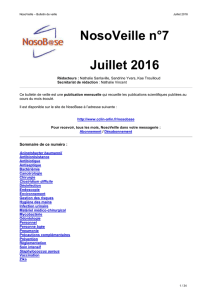NosoVeille - juin 2010
publicité
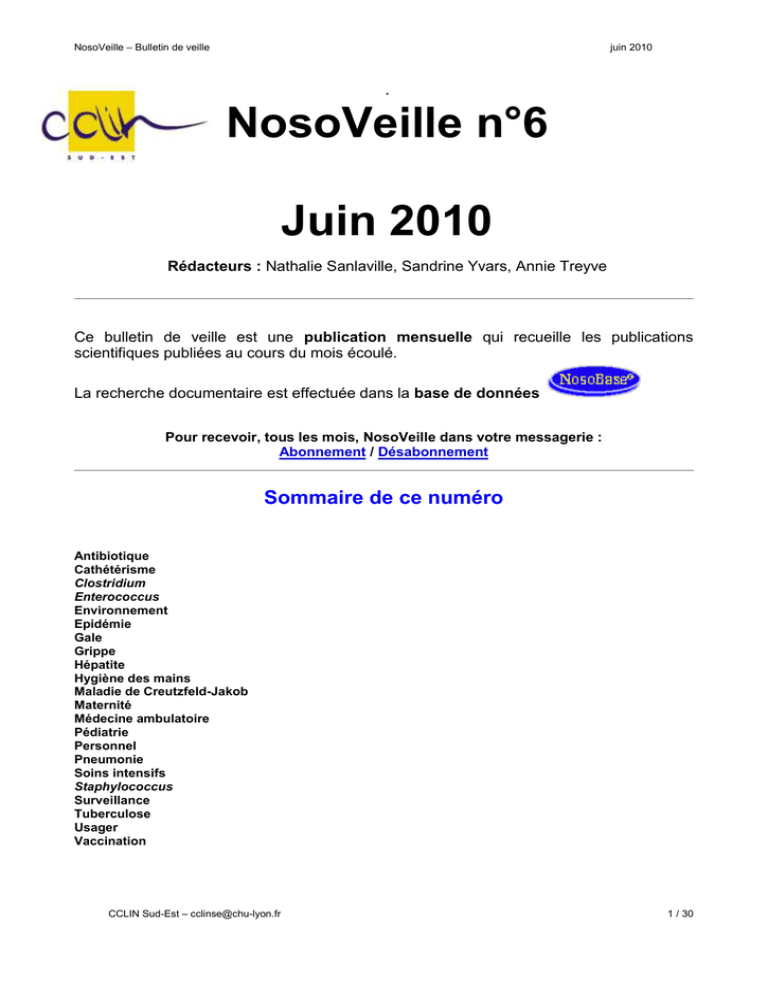
NosoVeille – Bulletin de veille juin 2010 . NosoVeille n°6 Juin 2010 Rédacteurs : Nathalie Sanlaville, Sandrine Yvars, Annie Treyve Ce bulletin de veille est une publication mensuelle qui recueille les publications scientifiques publiées au cours du mois écoulé. La recherche documentaire est effectuée dans la base de données Pour recevoir, tous les mois, NosoVeille dans votre messagerie : Abonnement / Désabonnement Sommaire de ce numéro Antibiotique Cathétérisme Clostridium Enterococcus Environnement Epidémie Gale Grippe Hépatite Hygiène des mains Maladie de Creutzfeld-Jakob Maternité Médecine ambulatoire Pédiatrie Personnel Pneumonie Soins intensifs Staphylococcus Surveillance Tuberculose Usager Vaccination CCLIN Sud-Est – [email protected] 1 / 30 NosoVeille – Bulletin de veille juin 2010 Antibiotique NosoBase n° 27242 Critères d'ajustement facilement disponibles pour la comparaison de la consommation des antibiotiques dans un milieu hospitalier : expérience en France Amadeo B; Dumartin C; Robinson P; Venier AG; Parneix P; Gachie JP; et al. Easily available adjustment criteria for the comparison of antibiotic consumption in a hospital setting: experience in France. Clinical microbiology and infection 2010/06; 16(6): 735-741. Mots-clés : ANTIBIOTIQUE; CONSOMMATION; DDJ; BACTERIEMIE; CATHETER VEINEUX CENTRAL; STATISTIQUE; DUREE DE SEJOUR Hospitals in France are encouraged to monitor antibiotic consumption (AbC) and it is known that this differs among hospitals. The aim of the current study was to identify relevant and easily available adjustment criteria for the purpose of benchmarking. We analysed data from 34 public non-teaching hospitals and 43 private hospitals located in south-western France and overseas departments using retrospective data from 2005. This study investigated the relationship between AbC expressed as defined daily doses per 1000 patient-days (DDD/1000 PDs) or per 100 admissions (DDD/100 admissions) and the number of venous central lines, the number of episodes of bacteraemia and various hospital characteristics. The relationship was tested using multiple linear analyses. The median total AbC in public hospitals was 395 DDD/1000 PDs (range, 196-737) and 341 DDD/100 admissions (range, 180-792). In private hospitals this was 422 DDD/1000 PDs (range, 113-717) and 212 DDD/100 admissions (range, 38-510). The best model for public hospitals included the proportion of PDs in surgery, intensive care and medical wards and explained 84% of the variability in AbC expressed as DDD/1000 PDs. For private hospitals, the mean length of stay and the proportion of PDs in surgery and medical wards explained 68% of the variability in AbC expressed as DDD/100 admissions. Overall, this French experience shows that relevant adjustment criteria for the comparison among hospitals are easily available. It is important that each country establish its own model considering the intrinsic peculiarities of the hospital system and taking into account both indicators (DDD/1000 PDs or DDD/100 admissions) to design the best model. NosoBase n° 27112 Rôle potentiel d’une surveillance active dans le contrôle d’une épidémie à Klebsiella pneumoniae résistant aux carbapénèmes sur l’ensemble de l’hôpital Ben-David D; Maor Y; Keller N; Regev-Yochay G; Tal I; Shachar D; et al. Potential role of active surveillance in the control of a hospital-wide outbreak of carbapenem-resistant Klebsiella pneumoniae infection. Infection control and hospital epidemiology 2010/06; 31(6): 620-626. Mots-clés : SURVEILLANCE; EPIDEMIE; KLEBSIELLA PNEUMONIAE; ANTIBIORESISTANCE; CARBAPENEME; ENTEROBACTERIE; TAUX; INCIDENCE; PRECAUTION CONTACT; COLONISATION; CENTRE HOSPITALIER UNIVERSITAIRE The recent emergence of carbapenem resistance among Enterobacteriaceae is a major threat for hospitalized patients, and effective strategies are needed. Objective: To assess the effect of an intensified intervention, which included active surveillance, on the incidence of infection with carbapenem-resistant Klebsiella pneumoniae. Setting: Sheba Medical Center, a 1,600-bed tertiary care teaching hospital in Tel Hashomer, Israel. Design. Quasi-experimental study. Methods: The medical records of all the patients who acquired a carbapenem-resistant K. pneumoniae infection during 2006 were reviewed. An intensified intervention was initiated in May 2007. In addition to contact precautions, active surveillance was initiated in high-risk units. The incidence of clinical carbapenem-resistant K. pneumoniae infection over time was measured, and interrupted time-series analysis was performed. Results: The incidence of clinical carbapenem-resistant K. pneumoniae infection increased 6.42-fold from the first quarter of 2006 up to the initiation of the intervention. In 2006, of the 120 patients whose clinical microbiologic culture results were positive for carbapenem-resistant K. pneumoniae, 67 (56%) developed a nosocomial infection. During the intervention period, the rate of carbapenem-resistant K. pneumoniae rectal CCLIN Sud-Est – [email protected] 2 / 30 NosoVeille – Bulletin de veille juin 2010 colonization was 9%. Of the 390 patients with carbapenem-resistant K. pneumoniae colonization or infection, 204 (52%) were identified by screening cultures. There were a total of 12,391 days of contact precautions, and of these, 4,713 (38%) were added as a result of active surveillance. After initiation of infection control measures, we observed a significant decrease in the incidence of carbapenem-resistant K. pneumoniae infection. Conclusions: The use of active surveillance and contact precautions, as part of a multifactorial intervention, may be an effective strategy to decrease rates of nosocomial transmission of carbapenem-resistant K. pneumoniae colonization or infection. NosoBase n° 27316 Prescription et surveillance des antibiotiques Gras G; Choutet P. La Revue du praticien 2010/04/20; 60: 573-579. Mots-clés : ANTIBIOTIQUE; SURVEILLANCE; ANTIBIORESISTANCE; PRESCRIPTION Le principal objectif d'un bon usage des antiobiotiques est d'obtenir la prévention ou une guérison complète et définitive d'une infection bactérienne et donc du malade en ayant une efficacité optimale, une bonne tolérance, des effets indésirables, dont la résistance bactérienne, minimaux et un coût acceptable pour la société. Une antibiothérapie adaptée impose au préalable un diagnostic précis. Ne sont pas abordées les antibiothérapies par voie locale (aérosols, cutanées, ORL, oculaires). NosoBase n° 27265 Analyse bénéfice-risque de la restriction de prescription des antibiotiques chez les enfants : que devons-nous vraiment savoir ? Keith T; Saxena S; Murray J; Sharland M. Risk-benefit analysis of restricting antimicrobial prescribing in children: what do we really know? Current opinion in infectious diseases 2010/06; 23(3): 242-246. Mots-clés : ANALYSE; ANTIBIOTIQUE; PRESCRIPTION; PEDIATRIE; RISQUE; ANTIBIORESISTANCE; TOLERANCE; EFFET INDESIRABLE; COUT; APPAREIL RESPIRATOIRE; COMPLICATION Purpose of review: Most childhood respiratory infections including acute otitis media (AOM), sore throat, upper respiratory tract infections (URTIs) and sinusitis are self-limiting illnesses. Yet, despite extensive guidance discouraging routine use of antibiotics to limit side-effects and combat antimicrobial resistance, antibiotic prescribing for these conditions remains high in many developed countries, fuelled by the fear of rare but serious bacterial complications including mastoiditis, quinsy, pneumonia and brain abscess. This review summarizes evidence for the role of antibiotics in preventing serious complications of URTIs in children. Recent findings: From a key observational study reporting antibiotic use in children, the calculated excess risk of suppurative complications of respiratory tract infections in children who did not receive an antibiotic was 3.8 per 10 000. Despite extensive searches of the literature, no data were found to assess the affect of antibiotics upon the risk of brain abscess after sinusitis in children. Summary: New information from observational studies suggests antibiotics show little benefit in preventing complications of mastoiditis following AOM, quinsy following sore throat and pneumonia following URTI/bronchitis. Further research should focus on stratifying the key risk factors for such complications and optimizing long-term monitoring strategies to detect any future changes in the risk-benefit analysis for antibiotic prescription. NosoBase n° 27251 Prévention et contrôle des infections nosocomiales et résistance aux antibiotiques en Europe ; d'abord ne pas nuire : éléments de prévention réussie et contrôle des infections associées aux soins CCLIN Sud-Est – [email protected] 3 / 30 NosoVeille – Bulletin de veille juin 2010 Mielke M. Prevention and control of nosocomial infections and resistance to antibiotics in Europe - Primum non-nocere: elements of successful prevention and control of healthcare-associated infections. International journal of medical microbiology 2010; in press: 5 pages. Mots-clés : PREVENTION; SURVEILLANCE CONTROLE; ANTIBIORESISTANCE; EUROPE; RECOMMANDATION; October 2004, the WHO launched the World Alliance for Patient Safety. In 2006, the Council of Europe adopted a recommendation on the management of patient safety and prevention of adverse events in healthcare to acknowledge that patients can expect each EU health system to secure a systematic approach to ensuring patient safety. This review is a compilation of broadly accepted instruments for the prevention and control of healthcare-associated infections and resistance to antibiotics in Europe. Antibiotic-resistant bacteria do not stop at the exit of a hospital. The implementation of the various elements of a whole bundle of recommended prevention and control measures in the context of interacting healthcare institutions including long-term care, rehabilitation facilities, ambulatory care practices, and home care, is therefore facilitated by the establishment of regional networks and the integration of prevention and control strategies into disease management programmes. In order to increase efficiency of prevention and control measures, there is a need for the careful design of interventional studies to figure out the most efficient single or bundle of preventive measures. In addition, methods for the discovery of clusters on the basis of routinely obtained data should be improved. NosoBase n° 27128 Antibioprophylaxie en chirurgie et médecine interventionnelle (patients adultes). Acutalisation 2010 SFAR; Martin C; Auboyer C; Dupont H; Gauzit R; Kitzis M; et al. 2010/04; 1-29. Mots-clés : ANTIBIOPROPHYLAXIE; ANTIBIOTIQUE; CHIRURGIE; RECOMMANDATION; NEUROCHIRURGIE; CHIRURGIE OPHTALMOLOGIQUE; CHIRRUGIE CARDIOVASCULAIRE; CHIRURGIR ORTHOPEDIQUE; TRAUMATOLOGIE; STOMATOLOGIE; CHIRURGIE DIGESTIVE; CHIRURGIE ORL; CHIRURGIE GYNECOLOGIQUE; RADIOLOGIE; ENDOCARDE Recommandations interventionnelle. de la SFAR concernant l’antibioprophylaxie en chirurgie et en médecine NosoBase n° 27097 Utilité de la prophylaxie antibiotique avant un geste dentaire pour les porteurs de prothèses totales du genou ou de la hanche Uckay I; Hoffmeyer P; Trampuz A; Borens O; Terzic A; Scolozzi P; et al. Revue médicale suisse 2010/04/07; : 727-730. Mots-clés : ANTIBIOPROPHYLAXIE; PROTHESE TOTALE DE GENOU; PROTHESE TOTALE DE HANCHE; ODONTOLOGIE; BACTERIEMIE; EFFICACITE; MICROBIOLOGIE; RECOMMANDATION Il est d'usage de prescrire une prophylaxie antibiotique aux patients porteurs de prothèses totales de la hanche ou de genou avant un geste dentaire. Cette attitude ne résiste pas à une analyse critique de l'évidence scientifique pour plusieurs raisons : 1) les pathogènes habituels de l'infection de prothèse ne sont pas de provenance buccale ; 2) même si administrés, les antibiotiques n'empêchent pas complètement des bactériémies occultes liées au traitement dentaire ; 3) l'être humain vit jusqu'à douze épisodes de bactériémies occultes d'origine dentaire par jour. Il importe donc de distinguer les situations d'infection buccale avérée dans lesquelles la prophylaxie antibiotique reste bien évidemment nécessaire. Une bonne hygiène dentaire est importante en termes de prévention et doit être encouragée chez tout porteur d'arthroplastie. CCLIN Sud-Est – [email protected] 4 / 30 NosoVeille – Bulletin de veille juin 2010 Cathétérisme NosoBase n° 27248 Efficacité et tolérance de la daptomycine dans le traitement des bactériémies à pathogènes à Gram positif liées aux cathéters chez des patients atteints de cancer Chaftari AM; Hachem R; Mulanovich V; Chemaly RF; Adachi J; Jacobson K; et al. Efficacy and safety of daptomycin in the treatment of Gram-positive catheter-related bloodstream infections in cancer patients. International journal of antimicrobial agents 2010; in press: 5 pages. Mots-clés : DAPTOMYCINE; EFFICACITE; TOLERANCE; BACTERIEMIE; BACTERIE A GRAM POSITIF; CATHETER; CANCER; VANCOMYCINE; ANTIBIORESISTANCE; STAPHYLOCOCCUS AUREUS; METICILLINO-RESISTANCE; ETUDE PROSPECTIVE Excessive vancomycin usage has contributed to the emergence of vancomycin-resistant enterococci, and a high vancomycin minimal inhibitory concentration (MIC) >1.0mug/mL has been associated with poor outcome in patients with meticillin-resistant Staphylococcus aureus (MRSA) infection. In view of these limitations, there is a need for an alternative agent. We evaluated the clinical efficacy and safety of daptomycin given as an alternative agent in the treatment of Gram-positive catheter-related bloodstream infections (CRBSIs) in cancer patients. Between June 2006 and March 2008, 40 patients with probable or definite CRBSI caused by Gram-positive organisms were prospectively enrolled to receive daptomycin intravenous 6mg/kg/day for up to 4 weeks. In addition, 40 historical matched control patients treated with vancomycin were retrospectively identified. The control group was matched based on underlying disease, organism and neutropenic status. The daptomycin group was comparable with the vancomycin group in terms of neutropenia rate, complications, adverse events, length of hospital stay and death. However, more patients in the daptomycin group achieved symptom resolution at 48h compared with the vancomycin group (76% vs. 53%; P=0.04). Similarly, more patients in the daptomycin group achieved microbiological eradication at 48h compared with the vancomycin group (78% vs. 34%; P<0.001). Although not significant, nephrotoxicity was almost three-fold lower in the daptomycin group. The overall response was significantly better for daptomycin compared with vancomycin (68% vs. 32%; P=0.003). In conclusion, compared with vancomycin, daptomycin treatment of Gram-positive CRBSI in cancer patients was significantly associated with earlier clinical and microbiological response as well as improved overall response. NosoBase n° 27234 Désinfection cutanée à l'aide de chlorhydrate d'octénidine pour le site d'insertion du cathéter veineux central : essai contrôlé, randomisé, en double aveugle Dettenkofer M; Wilson C; Gratwohl A; Schmoor C; Bertz H; Frei R; et al. Skin disinfection with octenidine dihydrochloride for central venous catheter site care: a double-blind, randomized, controlled trial. Clinical microbiology and infection 2010/06; 16(6): 600-606. Mots-clés : PEAU; CATHETER VEINEUX CENTRAL; ANTISEPTIQUE; ESSAI THERAPEUTIQUE; ALCOOL; BACTERIEMIE; COLONISATION CUTANEE; PREVENTION; RANDOMISATION To compare the efficacy of two commercially available, alcohol-based antiseptic solutions for preparation and care of central venous catheter (CVC) insertion sites, with and without octenidine dihydrochloride, a double-blind, randomized, controlled trial was undertaken in the haematology units and in one surgical unit of two university hospitals. Adult patients with a non-tunnelled CVC were randomly assigned to two different skin disinfection regimens at the insertion site: 0.1% octenidine with 30% 1-propanol and 45% 2-propanol, and as control 74% ethanol with 10% 2-propanol. Endpoints were (i) skin colonization at the insertion site; (ii) positive culture from the catheter tip (>/=15 CFU); and (iii) occurrence of CVC-associated bloodstream infection (defined according to criteria set by the CDC). Four hundred patients with inserted CVC were enrolled from May 2002 through April 2005. Both groups were similar in respect of patient characteristics and co-morbidities. Skin colonization at the CVC insertion site during the first 10 days was significantly reduced by octenidine treatment (relative difference octenidine vs. control: 0.21; 95%CI: 0.11-0.39, p <0.0001). Positive culture of the catheter tip was significantly less frequent in the octenidine group (7.9%) than in the control group (17.8%): OR = 0.39 (95%CI: 0.20-0.80, p 0.009). Patients treated with octenidine had a non-significant reduction in catheter-associated bloodstream infections (4.1% vs. 8.3%; OR = 0.44; CCLIN Sud-Est – [email protected] 5 / 30 NosoVeille – Bulletin de veille juin 2010 95%CI: 0.18-1.08, p 0.081). Side effects were similar in both groups. This randomized controlled trial supports the results of two observational studies demonstrating octenidine in alcoholic solution to be a better option than alcohol alone for the prevention of CVC-associated infections. NosoBase n° 27243 Développement de bactériémie ou de fongémie après ablation de cathéters veineux centraux colonisés chez des patients présentant des hémocultures concomitantes négatives Park KH; Song EH; Jang EY; Lee EJ; Chong YP; Choi SH; et al. Development of bacteraemia on fungaemia after removal of colonized central venous catheters in patients with negative concomitant blood cultures. Clinical microbiology and infection 2010/06; 16(6): 742-746. Mots-clés : COLONISATION; CATHETER HEMOCULTURE; MICROBIOLOGIE VEINEUX CENTRAL; BACTERIEMIE; FONGEMIE; There are limited data on the clinical significance of positive central venous catheter (CVC) tip cultures associated with concomitant negative blood cultures performed at the time of CVC removal. A retrospective cohort study of all patients who yielded isolated positive CVC tip cultures was conducted in a tertiary-care hospital with 2200 beds during a 10-year period. All patients with isolated positive CVC tip cultures were observed for the development of subsequent bacteraemia or fungaemia between 2 and 28 days after CVC removal. An isolated positive CVC tip culture was defined as a case in which (i) a CVC tip culture yielded >/=15 colonies using a semiquantitative culture method and (ii) at least two sets of blood samples revealed no organism at, or close to, the time of CVC removal (48 h before to 48 h after CVC removal). During the study period, 312 patients with isolated positive CVC cultures were enrolled. Eight (2.6%; 95% CI 1.2-5.1) of the 312 patients yielding isolated bacterial or fungal CVC tip cultures developed subsequent bloodstream infection (BSI) caused by the same species as that isolated from the tip culture (Staphylococcus aureus, 1: Enterococcus spp.; 2: Pseudomonas aeruginosa; and 3: Candida spp.). Among 125 patients from whose CVC tips the above four organisms were grown, seven (12.3%) of 57 patients who did not receive appropriate antibiotic therapy within 48 h after CVC removal subsequently developed BSI, but only one (1.5%) of 68 patients who did receive appropriate therapy developed BSI (OR 0.11, p 0.02). NosoBase n° 27290 Impacts bactéricides des sondes endotrachéales imprégnées d'argent et de dioxyde de titane sur Pseudomonas aeruginosa et Staphylococcus aureus Tarquinio KM; Kothurkar NK; Goswami DY; Sanders RC; Zaritsky AL; Levine AM. Bactericidal effects of silver plus titanium dioxide-coated endotracheal tubes on Pseudomonas aeruginosa and Staphylococcus aureus. International journal of nanomedicine 2010/04/07; 5: 177-183. Mots-clés : STAPHYLOCOCCUS AUREUS; BACTERICIDIE; PSEUDOMONAS AERUGINOSA; CATHETER IMPREGNE; INTUBATION; PNEUMONIE; VENTILATION ASSISTEE; PREVENTION; COLONISATION Purpose: Ventilator-associated pneumonia (VAP) is a nosocomial infection resulting in significant morbidity and mortality. Pseudomonas aeruginosa (P. aeruginosa) and Staphylococcus aureus (S. aureus) are pathogens associated with VAP. Silver (Ag) coating of endotracheal tubes (ETTs) reduces bacterial colonization, however titanium dioxide (TiO(2)) coating has not been studied. Methods: Five types of ETT coatings were applied over silica layer: Ag, solgel TiO(2), solgel TiO(2) with Ag, Degussa P25 TiO(2) (Degussa TiO(2)), and Degussa TiO(2) with Ag. After ETTs were incubated with P. aeruginosa or S. aureus; colonization was determined quantitatively. Results: Pseudomonas aeruginosa and S. aureus grew for 5 days on standard ETTs. Compared to standard ETTs, P. aeruginosa growth was significantly inhibited by solgel TiO(2) with Ag at 24 hours, and by Degussa TiO(2) with Ag at 24 and 48 hours after inoculation. No significant difference in S. aureus growth was observed between the control and any of the five coatings for 5 days. Conclusion: In vitro, solgel TiO(2) with Ag and Degussa TiO(2) with Ag both attenuated P. aeruginosa growth, but demonstrated no effect on S. aureus colonization. Further studies using alternative coating and incorporating UV light exposure are needed to identify their potential utility in reducing VAP. CCLIN Sud-Est – [email protected] 6 / 30 NosoVeille – Bulletin de veille juin 2010 Clostridium NosoBase n° 27115 Pseudo-épidémie d’infections à Clostridium sordellii suite à une probable contamination croisée dans un laboratoire de microbiologie hospitalier Aronoff DM; Thelen T; Walk ST; Petersen K; Jackson J; Grossman S; et al. Pseudo-outbreak of Clostridium sordellii infection following probable cross-contamination in a hospital clinical microbiology laboratory. Infection control and hospital epidemiology 2010/06; 31(6): 640-642. Mots-clés : LABORATOIRE; MICROBIOLOGIE; CLOSTRIDIUM; CONTAMINATION We report a pseudo-outbreak of infection caused by Clostridium sordellii, an uncommon human pathogen. The pseudo-outbreak involved 6 patients and was temporally associated with a change by the clinical microbiology laboratory in the protocol of handling anaerobic culture specimens. All isolates were genetically indistinguishable from a laboratory reference strain used for quality control. NosoBase n° 27247 Synthèse sur la prise en charge médicale et chirurgicale des infections à Clostridium difficile Faris B; Blackmore A; Haboubi N. Review of medical and surgical management of Clostridium difficile infection.Techniques in coloproctology 2010; in press: 9 pages. Mots-clés : CLOSTRIDIUM DIFFICILE; BIBLIOGRAPHIE; TRAITEMENT; MICROBIOLOGIE; DIAGNOSTIC; ENDOSCOPIE; CHIRURGIE; MORTALITE EPIDEMIOLOGIE; Clostridium difficile infection (CDI) has become an important area in our daily clinical practice. C. difficile is known to cause a broad spectrum of conditions ranging from asymptomatic carriage, through mild or moderately severe disease with watery diarrhoea, to the life-threatening pseudomembranous colitis (PMC), with toxic megacolon and ileus. Peoples who have been treated with broad-spectrum antibiotics, patients with serious underlying co-morbidities and the elderly are at greatest risk. Over 80% of CDIs reported are in people aged over 65. Due to the alarming increase in its frequency, appearance of more virulent strains and occasional need for life-saving surgical intervention, a more coherent multidisciplinary approach is needed. Combination of rapid turn round time and accurate diagnosis will result in a better management of CDI and a timely implementation of infection control measure. Discontinuation of causative agents such as antibiotic treatment is often curative. In more serious cases, oral administration of metronidazole or vancomycin is the treatment of choice. Relapses of CDI have been reported in about 20-25% of cases, this may increase to 45-60% after the first recurrence. Patients should be treated as soon as possible when the diagnosis of Clostridium difficile colitis is made to avoid sepsis or bowel perforation. Colectomy may improve the outcome of the patient with systemic or complicated Clostridium difficile colitis. This article reviews the changing epidemiological picture, microbiology, histopathology and both medical and surgical managements. NosoBase n° 27103 Efficacité des solutions hydro-alcooliques pour éliminer les spores de Clostridium difficile des mains Jabbar U; Leischner J; Kasper D; Gerber R; Sambol SP; Parada JP; et al. Effectiveness of alcohol-based hand rubs for removal of Clostridium difficile spores from hands. Infection control and hospital epidemiology 2010/06; 31(6): 565-570. Mots-clés : CLOSTRIDIUM DIFFICILE; SOLUTION HYDROALCOOLIQUE; HYGIENE DES MAINS; LAVAGE SIMPLE DES MAINS Background: Alcohol-based hand rubs (ABHRs) are an effective means of decreasing the transmission of bacterial pathogens. Alcohol is not effective against Clostridium difficile spores. We examined the retention CCLIN Sud-Est – [email protected] 7 / 30 NosoVeille – Bulletin de veille juin 2010 of C. difficile spores on the hands of volunteers after ABHR use and the subsequent transfer of these spores through physical contact. Methods: Nontoxigenic C. difficile spores were spread on the bare palms of 10 volunteers. Use of 3 ABHRs and chlorhexidine soap-and-water washing were compared with plain water rubbing alone for removal of C. difficile spores. Palmar cultures were performed before and after hand decontamination by means of a plate stamping method. Transferability of C. difficile after application of ABHR was tested by having each volunteer shake hands with an uninoculated volunteer. Results: Plain water rubbing reduced palmar culture counts by a mean (+/- standard deviation [SD]) of 1.57 +/- 0.11 log(10) colony-forming units (CFU) per cm(2), and this value was set as the zero point for the other products. Compared with water washing, chlorhexidine soap washing reduced spore counts by a mean (+/SD) of 0.89 +/- 0.34 log(10) CFU per cm(2); among the ABHRs, Isagel accounted for a reduction of 0.11 +/0.20 log(10) CFU per cm(2) ([Formula: see text]), Endure for a reduction of 0.37 +/- 0.42 log(10) CFU per cm(2) ([Formula: see text]), and Purell for a reduction of 0.14 +/- 0.33 log(10) CFU per cm(2) ([Formula: see text]). There were no statistically significant differences between the reductions achieved by the ABHRs; only Endure had a reduction statistically different from that for water control rubbing ([Formula: see text]). After ABHR use, handshaking transferred a mean of 30% of the residual C. difficile spores to the hands of recipients. Conclusions: Hand washing with soap and water is significantly more effective at removing C. difficile spores from the hands of volunteers than are ABHRs. Residual spores are readily transferred by a handshake after use of ABHR. NosoBase n° 27104 Révision des techniques d’hygiène des mains et de la communication sur ce sujet au moment où les colonisations et les infections à Clostridium difficile augmentent Ellingson K; Mcdonald C. Reexamining methods and messaging for hand hygiene in the era of increasing Clostridium difficile colonization and infection. Infection control and hospital epidemiology 2010/06; 31(6): 571-573. Mots-clés : CLOSTRIDIUM FORMATION DIFFICILE; COLONISATION; INFECTION; HYGIENE DES MAINS; Réponse à l’article n° 27103. NosoBase n° 27255 Infection associée à Clostridium difficile acquise en réanimation neurologique Musa SA; Robertshaw H; Thomson SJ; Cowan ML; Rahman TM. Clostridium difficile-associated disease acquired in the neurocritical care unit. Neurocritical care 2010; in press: 6 pages. Mots-clés : CLOSTRIDIUM DIFFICILE; SOIN INTENSIF; PREVALENCE; NEUROLOGIE; FACTEUR DE RISQUE; ANTIBIOTIQUE; NEUROCHIRURGIE Background: Clostridium difficile is an important cause of nosocomial infection on the intensive care unit. Little is known about infection rates on the neurocritical care unit (NICU). The purpose of this study was to determine the prevalence, severity, and outcome associated with Clostridium difficile-associated disease (CDAD) acquired on the NICU. Methods: Patients on NICU with a positive stool Clostridium difficile toxin assay, from August 2004 to February 2008, were identified by the Department of Microbiology. Each patient's medical notes and charts were reviewed in turn. Patients with a positive assay within 48 h of NICU admission were excluded. Results: Twenty-one (0.6%) NICU patients developed CDAD. All were emergency admissions, 18 (86.0%) were neurosurgical. Subarachnoid hemorrhage was the most common diagnosis, 5 (23.8%) patients. Median age and APACHE II score on admission were 55 (IQR 40-66) and 21 (IQR 16-24), respectively. Thirteen (61.9%) patients were female. Median interval between NICU admission and diarrhea onset and CDAD diagnosis were 5 (3-8) days and 7 (4-12) days, respectively. At the time of diagnosis most, 11 (52.4%) patients, had moderate CDAD. Previously identified risk factors for ICU-acquired CDAD comprised: age > 65 (6), antibiotics (21), and medical device requirements (21). Five (23.8%) patients deteriorated CCLIN Sud-Est – [email protected] 8 / 30 NosoVeille – Bulletin de veille juin 2010 clinically as a result of CDAD. The overall in-hospital mortality for those with NICU acquired CDAD was 19%. Conclusions: Although CDAD is rarely acquired on the NICU, up to one quarter of affected patients may experience complications. Prospective validation of severity definitions and treatment guidelines may help to reduce the complication rates. Enterococcus NosoBase n° 27232 Prise en charge des infections à entérocoques multirésistants aux antibiotiques Arias CA; Contreras GA; Murray BE. Management of multidrug-resistant enterococcal infections. Clinical microbiology and infection 2010/06; 16(6): 555-562 Mots-clés : BIBLIOGRAPHIE; MULTIRESISTANCE; ENTEROCOCCUS; ENTEROCOCCUS FAECIUM; ANTIBIORESISTANCE; AMPICILLINE; VANCOMYCINE; AMINOSIDE; TRAITEMENT; ENTEROCOCCUS FAECALIS Enterococci are organisms with a remarkable ability to adapt to the environment and acquire antibiotic resistance determinants. The evolution of antimicrobial resistance in these organisms poses enormous challenges for clinicians when faced with patients affected with severe infections. The increased prevalence and dissemination of multi-drug resistant Enterococcus faecium worldwide has resulted in a major decrease in therapeutic options, since the majority of E. faecium isolates are now resistant to ampicillin, vancomycin and exhibit high-level resistance to aminoglycosides, three of the traditionally most useful anti-enterococcal antibiotics. Newer antibiotics such as linezolid, daptomycin and tigecycline have good in vitro activity against enterococcal isolates but their clinical use may be limited in certain clinical scenarios due to reduced rates of success, possible underdosing for enterococci and low serum levels, respectively, and also by the emergence of resistance. The experimental agent oritavancin may offer some hope for the treatment of vancomycin-resistant enterococci but clinical data are still lacking. Thus, optimal therapies for the treatment of multi-drug resistant enterococcal infections continue to be based on empirical observations and extrapolations from in vitro and animal data. Clinical studies evaluating new strategies, including combination therapies to treat severe vancomycin-resistant E. faecium infections are urgently needed. NosoBase n° 27257 Nouveau test PCR multiplex pour la détection simultanée d'entérocoques résistant à la vancomycine dans des prélèvements rectaux Benadof D; San Martin M; Aguirre J; Paredes L; Malig R; Melo F; et al. A new multiplex PCR assay for the simultaneous detection of vancomycin-resistant enterococci from rectal swabs. The Journal of infection 2010; (60): 354-359. Mots-clés : PCR MULTIPLEX; PRELEVEMENT; ENTEROCOCCUS; VANCOMYCINE; ANTIBIORESISTANCE; ENTEROCOCCUS RESISTANT A LA VANCOMYCINE; BIOLOGIE MOLECULAIRE; DIAGNOSTIC; ENTEROCOCCUS FAECIUM; ENTEROCOCCUS FAECALIS; SENSIBILITE; SPECIFICITE Objectives: This study describes the diagnostic performance of a recently available multiplex PCR-based kit for the simultaneous detection and identification of Enterococcus faecium, Enterococcus faecalis, vanA, vanB, vanC1 and vanC2/C3 genes, directly from rectal swabs constituting the most complete existing molecular assay currently available. Methods: The diagnostic performance of this assay was evaluated by a multicenter study involving three independent public hospitals and consisted in the analysis of 187 rectal swabs from patients at high risk for vancomycin-resistant enterococci colonization. Results: When bacteria culture was used as the gold standard, the sensitivity, specificity, positive and negative predicted values for the assay were 96.8%, 76.0%, 67.7% and 97.9%, respectively. When a composite reference standard consisting of culture and DNA sequencing of PCR products was used as the gold standard, the sensitivity, specificity, positive and negative predicted values for the PCR-based assay were 97.8%, 96.9%, 96.7% and 97.9%, respectively. CCLIN Sud-Est – [email protected] 9 / 30 NosoVeille – Bulletin de veille juin 2010 Conclusions: Based on these results, we conclude that this assay is considerably more sensitive than traditional microbiological methods for detecting vancomycin-resistant enterococci from rectal swabs. It is also much faster than culture. We believe that the implementation of this assay in routine clinical laboratories could help to reduce hospital-acquired vancomycin-resistant enterococci infections. Environnement NosoBase n° 27206 Réduction de la surface de contamination bactérienne dans l'environnement hospitalier par application d'un nouveau produit à effet rémanent Hedin G; Rynback J; Lore B. Reduction of bacterial surface contamination in the hospital environment by application of a new product with persistent effect. The Journal of hospital infection 2010/06; 75(2): 112-115. Mots-clés : CONTAMINATION; SURFACE; ENVIRONNEMENT; DESINFECTANT; BIGUANIDE; TEST The benefit of routine surface disinfection in hospitals has been discussed. In this study we have investigated a new product, Appeartex. After application on surfaces a remnant effect is achieved due to the positive charge of the active molecule. We studied the persistent effect of Appeartex one day after application in both an experimental study in the laboratory and a field study in a hospital ward. Surfaces of bedside tables were investigated. In the experimental study, large inocula of >or=10(6)cfu of S. aureus or enterococci were inoculated on to well-defined areas which had been treated/not treated with Appeartex. One hour later, samples were taken with a swab rinse technique. A reduction in the number of viable bacteria in the magnitude 10-10(3) cfu was seen due to the effect of Appeartex. In the field study the effect on naturally occurring low level contamination was studied. Defined surfaces on bedside tables used by patients were treated/not treated with Appeartex. One day later, samples were taken with contact agar plates and with a new swab method using two sequential nylon flocked swabs. Significantly fewer bacteria were found on Appeartex-treated surfaces compared with untreated surfaces. The median counts on Appeartex-treated surfaces were 10 cfu/50 cm(2), and on untreated surfaces 20 cfu/50 cm(2). There was no significant difference in the number of bacteria found by culture of samples taken with the contact agar method compared with samples taken using the nylon flocked swab method. NosoBase n° 27332 Les cadres font "verdir" l'hôpital Langlois G. Objectif soins 2010/05; (186): 19-21. Mots-clés : ENVIRONNEMENT ; STRUCTURE DE SOINS ; NETTOYAGE; VAPEUR; JAVEL; BIONETTOYAGE; DIALYSE RENALE Elle a beau ne concerner que la construction, la norme de haute qualité environnementale (HQE) a cela de bon qu'elle modifie les conditions de travail des agents comme des responsables et met les équipes sur les rails du développement durale. A charge pour tous, ensuite, d'enrichir la démarche sur les plans humains, social et écologique. Epidémie NosoBase n° 27238 Impact des procédures de diagnostic sur la prise en charge des patients et les coûts d'hospitalisation au cours des épidémies d'infections à entérovirus en 2000 et 2005 à Marseille, France Ninove L; Tan C; Nougairede A; Zandotti C; Richet H; Charrel R; et al. Impact of diagnostic procedures on patient management and hospitalization cost during the 2000 and 2005 enterovirus epidemics in Marseilles, France. Clinical microbiology and infection 2010/06; 16(6): 651-656. CCLIN Sud-Est – [email protected] 10 / 30 NosoVeille – Bulletin de veille juin 2010 Mots-clés : EPIDEMIOLOGIE; DIAGNOSTIC; COUT; ENTEROVIRUS; RT-PCR; EPIDEMIE; PROTOCOLE; DIAGNOSTIC BIOLOGIQUE Enteroviruses are frequent aetiological agents of central nervous system infections in humans. In 2000 and 2005, two large outbreaks of Echovirus 30 (a member of species human enterovirusB) were observed in the University Hospitals of Marseilles (France). Between the two epidemics, the diagnostic protocols for enterovirus infection were modified, moving from viral cultures and classic RT-PCR in 2000 to real-time RTPCR in 2005. We compared some viral and epidemiological characteristics of the 2000 and 2005 outbreaks with special attention to diagnostic procedures and to the subsequent clinical management of patients. Despite similar virological and epidemiological characteristics during both outbreaks, our results show that real-time RT-PCR techniques used in 2005 noticeably shortened the period of time necessary to deliver diagnostic results and suggest that this was associated with a decrease in the duration of hospitalization for positive cases. In conclusion, this study suggests that the improvement of enterovirus diagnosis had a major financial impact on the management of the 2005 epidemic in Marseilles and may constitute an interesting example of how new diagnostic methods in microbiology can be self-financed through improvement in patient management. NosoBase n° 27154 Co-circulation de multiples génotypes du virus de la rougeole durant une épidémie en France en 2008 Waku-Kouomou D; Freymuth F; Parent du Chatelet I; Wild tf; Horvat B. Co-circulation of multiple measles virus genotypes during an epidemic in France in 2008. Journal of medical virology 2010/05; 82(6): 10331043. Mots-clés : VIRUS; ROUGEOLE; SURVEILLANCE; RESEAU EPIDEMIE; BIOLOGIE MOLECULAIRE; PCR; GENOTYPE; In 2008, measles reappeared in France in a series of outbreaks. During this period, 604 measles cases were reported to a routine surveillance system and 305 (50%) of these cases were then confirmed in the laboratory. To understand better the current epidemiological situation and the circulation of different measles strains, a phylogenetic characterization of 113 (19%) of the measles cases from these outbreaks was performed. All measles cases met the WHO clinical criteria and were confirmed either by laboratory detection of measles-specific IgM and/or by detection of the virus genome by polymerase chain reaction (PCR) and viral isolation. PCR products generated from blood, oral fluid, urine, or nasopharyngeal-swab samples were sequenced for molecular epidemiology studies. Phylogenetic analysis showed a co-circulation of genotypes D4 and D5 during the first measles outbreak in the city of Reims in early 2008. Over the course of the year, the A, B3.2, D8, and D9 genotypes also appeared. The data from this study show the simultaneous circulation of several measles genotypes in France and describe genotypes D8 and D9 for the first time in this country. The data also suggest that there are still many pockets of unvaccinated individuals helping to maintain the circulation of measles virus in the population. Phylogenetic studies allowed the corroboration of epidemiologic links and showed that nosocomial transmission can create significant risk for measles dissemination. Finally, the pattern of changes in viral genotypes during 2008 suggests a regular introduction of measles strains from abroad. Gale NosoBase n° 27312 Recommandations de traitement en cas de gale dans les hôpitaux de soins aigus et les institutions de longs séjours Buhlmann M; Itin P; Bellini C; Zanetti G; Widmer AF. Swiss-NOSO 2010; 16(2): 4-6. Mots-clés : RECOMMANDATION; GALE; SOIN DE LONGUE DUREE; TRAITEMENT; STRUCTURE DE SOINS; PERSONNE AGEE; GANT; PRECAUTION COMPLEMENTAIRE; PREVENTION; MEDICAMENT; BLOUSE A l'apparition d'un cas de gale, les mesures suivantes sont indiquées : CCLIN Sud-Est – [email protected] 11 / 30 NosoVeille – Bulletin de veille juin 2010 1. Le diagnostic doit être confirmé par un dermatologue expérimenté 2. Port de surblouse de protection et gants à usage unique lors des soins directs, ou application des mesures additionnelles de contact 3. Traitement des personnes atteintes de gale documentée 4. Traitement concomitant des personnes exposées dans l'hôpital 5. Traitement concomitant de l'entourage du patient 6. Fixer un jour au cours duquel toutes les personnes impliquées se traitent simultanément 7. Jusqu'au jour fixé : port de surblouse de protection et gants à usage unique lors des soins directs 8. Pour l'interruption de l'épidémie, adopter la règle : "Hit hard and early". Grippe NosoBase n° 27157 Prise en charge clinique de la pandémie de grippe A(H1N1) 2009 Hui DS; Lee N; Chan P. Clinical management of pandemic 2009 influenza A(H1N1) infection. Chest 2010/04; 137(4): 916-925. Mots-clés : GRIPPE; EPIDEMIE; PREVENTION; VACCIN TRAITEMENT; CONTROLE; VIRUS; FACTEUR DE RISQUE; Antiviral therapy and vaccination are important strategies for controlling pandemic 2009 influenza A(H1N1) but efficacy depends on the timing of administration and is often limited by supply shortage. Patients with dyspnea, tachypnea, evidence of hypoxemia, and pulmonary infiltrates on chest radiograph should be hospitalized. Patients with severe illness or underlying medical conditions that increase the risk of more severe disease should be treated with oseltamivir or zanamivir as soon as possible, without waiting for the results of laboratory tests. Lung-protective ventilation strategy with a low tidal volume and adequate pressure, in addition to a conservative fluid management approach, is recommended when treating adult patients with ARDS. Extracorporeal membrane oxygenation has emerged as an important rescue therapy for critically ill patients. Use of systemic steroids was associated with delayed viral clearance in severe acute respiratory syndrome and H3N2 infection. Low-dose corticosteroids may be considered in the treatment of refractory septic shock. Passive immunotherapy in the form of convalescent plasma or hyperimmune globulin may be explored as rescue therapy. More data are needed to explore the potential role of IV gamma globulin and other drugs with immunomodulating properties, such as statins, gemfibrozil, and Nacetyl-cysteine. Health-care workers must apply strict standard and droplet precautions when dealing with suspected and confirmed case and upgrade to airborne precautions when performing aerosol-generating procedures. Nonpharmacologic measures, such as early case isolation, household quarantine, school/workplace closure, good community hygiene, and restrictions on travel are useful measures in controlling an influenza pandemic at its early phase. NosoBase n° 27250 Intervention destinée à améliorer l'observance des précautions liées à la transmission de la grippe dans le service des urgences : succès et défis May L; Lung D; Harter K. An intervention to improve compliance with transmission precautions for influenza in the emergency department: successes and challenges. The journal of emergency medicine 2010; in press: 7 pages. Mots-clés : TRANSMISSION; GRIPPE; OBSERVANCE; TRANSPORT; RETROSPECTIVE; URGENCE; PRECAUTION GOUTTELETTE PREVENTION; ETUDE Concern with the potential for hospital-based transmission of influenza has come to the forefront due to emergency department (ED) crowding and the novel H1N1 pandemic. Compliance with infection control guidelines for influenza in the ED is generally unknown, and effective yet low-resource training is needed to educate staff on the importance of decreasing the potential for ED transmission of the virus. Objectives: This study evaluates compliance with patient assignment and transport precautions for influenza in an urban ED before and after implementation of electronic reminders. Methods: We included patients with a diagnosis of influenza for two consecutive influenza seasons, and retrospectively collected limited patient encounter data CCLIN Sud-Est – [email protected] 12 / 30 NosoVeille – Bulletin de veille juin 2010 on patient location, transport, and compliance with assignment and transport precautions for both years. For the second influenza season we sent monthly reminders to all ED providers via the electronic medical record (EMR), explaining the importance and proper use of infection control precautions in patients with suspected influenza. Compliance between the two seasons was compared using descriptive statistics and chi-squared analysis. Results: Overall compliance with infection control precautions was poor, but increased with the use of electronic reminders from 29% to 45% (p = 0.015). Compliance with precautions for patients moved to the hallway or Radiology increased from 7% to 24% (p = 0.001). Conclusions: The EMR may be a useful tool for improving compliance with transmission-based precautions by implementing reminders on order sets and informational mailings, and by tracking compliance. Future study should be undertaken to determine the most effective interventions to prevent ED transmission of influenza. NosoBase n° 27068 Performance d'un test rapide contre la grippe chez des enfants hospitalisés Stripeli F; Sakkou Z; Papadopoulos N; Georgiou V; Gratsia P; Christodoulou I; et al. Performance of rapid influenza testing in hospitalized children. european journal of clinical microbiology and infectious disease 2010; in press: 6 pages. Mots-clés : GRIPPE; PEDIATRIE; DIAGNOSTIC; PCR; RT-PCR; SENSIBILITE; SPECIFICITE Influenza infection is associated with high hospitalization rates among young children. Rapid diagnosis of influenza infection is particularly useful in order to prevent nosocomial infection and allows for the timely initiation of antiviral treatment. We evaluated the performance of a rapid influenza test in hospitalized children during the influenza season. All children (aged 6 months to 14 years) hospitalized with fever and/or respiratory symptoms, admitted during the 2005 influenza season, participated in the study. A multiplex reverse transcriptase polymerase chain reaction (RT-PCR), able to identify IFV-A H1N1, H3N2, and IFV-B subtypes, was performed on nasopharyngeal aspirates. The nasal swab was tested with a lateral-flow immunoassay (QuickVue Influenza Test). The performance of the rapid test was compared with the results of PCR. Influenza infection was diagnosed by PCR in 41/217 (19%) patients. Infection with influenza A virus (H3N2) was diagnosed in all cases. The performance of the QuickVue Influenza Test was estimated as follows: sensitivity 67.5%, specificity 96%, positive predictive value 79%, and negative predictive value 93%. The sensitivity of the test was higher in infants aged 6-12 months, in those with short duration of symptoms, and in the peak phase of the epidemic. The QuickVue Influenza Test is useful and reasonably accurate to detect influenza infection in hospitalized children during the influenza season. Infection with influenza virus is unlikely if the test is negative. A positive result suggests that infection is probable if influenza virus circulates in the community. Hépatite NosoBase n° 27315 Hépatite aiguë C : infection nosocomiale ou communautaire ? Bourigault C; Nael V; Garnier E; Coste-Burel M; Chevaliez S; Villers D; et al. Acute hepatitis C virus infection: hospital or community-acquired infection? BEH Web 2010/05/17; 1: 1-4. Mots-clés : HEPATITE C; INFECTION COMMUNAUTAIRE; TRANSPLANTATION; MUCOVISCIDOSE; HOSPITALISATION A DOMICILE; INVESTIGATION; PERSONNEL; TRANSMISSION SOIGNANT-SOIGNE En 2008, une infection aiguë par le virus de l’hépatite C (VHC) a été diagnostiquée lors du bilan pré-greffe d’une patiente de 29 ans atteinte de mucoviscidose. Une investigation épidémiologique a été réalisée pour déterminer les facteurs de risque éventuels de la contamination. Les investigations n’ont pas retrouvé d’argument en faveur d’une contamination par le VHC au sein de l’établissement. L’un des trois personnels soignants ayant réalisé des soins au domicile de la patiente était séropositif pour le VHC, statut sérologique ignoré avant le dépistage en juillet 2009. Les analyses génétique et phylogénique des souches de VHC issues de la patiente et du soignant ont montré que les deux souches étaient proches. Ces analyses ne permettent en aucun cas de préjuger du sens de la contamination. L’évaluation des pratiques de soins à domicile reste nécessaire afin d’évaluer le risque encouru par les personnes soignées par un professionnel séropositif. CCLIN Sud-Est – [email protected] 13 / 30 NosoVeille – Bulletin de veille juin 2010 NosoBase n° 27169 Infection par le virus de l'hépatite E en dialyse et après transplantation Kamar N; Abravanel F; Mansuy JM; Peron JM; Izopet J; Rostaing L. Hepatitis E infection in dialysis and after transplantation. Nephrologie et therapeutique 2010/04; 6(2): 83-87. Mots-clés : HEPATITE E; DIALYSE RENALE; TRANSPLANTATION; TRANSMISSION; TRAITEMENT; PREVALENCE; INCIDENCE Le virus de l'hépatite E (VHE) est un virus à ARN responsable d'épidémies dans les pays en voie de développement et semble être un agent émergent dans les pays industrialisés. Il est transmis essentiellement selon un mode féco-oral. L'infection par le VHE est une zoonose. Le VHE était considéré comme une hépatite uniquement responsable d'hépatite aiguë, qui n'évolue pas vers l'hépatite chronique et la cirrhose. Récemment, il a été montré que l'hépatite E peut évoluer vers la chronicité et la cirrhose au moins chez les patients immunodéprimés. Dans ce cas, la réduction de l'immunosuppression pourrait être une première option thérapeutique. NosoBase n° 27272 Prévention de l'hépatite C chez des patients hémodialysés : 5 ans d'expérience dans un centre d'hémodialyse Mohamed WZ. Prevention of hepatitis C virus in hemodialysis patients: five years experience from a single center. Saudi journal of kidney diseases and transplantation 2010/06; 21(3): 548-554. Mots-clés : PREVENTION; HEPATITE C; VIRUS; HEMODIALYSE; RECOMMANDATION; INCIDENCE; TRANSMISSION; OBSERVANCE; PRECAUTION STANDARD; DEPISTAGE Hepatitis C virus (HCV) has been a significant problem in hemodialysis (HD) patients. In general, it carries significant morbidity including liver cirrhosis, liver cell failure and hepa-toma. The study was conducted on 36 seronegative HD patients. All patients were managed with strict application of infection control guidelines as well as isolation of HCV-positive patients. None of the patients received any blood transfusions and were managed with iron and erythro-poietin. After five years of follow-up, we found that the incidence of HCV seroconversion was zero. Our study further suggests that following infection control guidelines, isolation of sero-positive patients and minimizing blood transfusions can help in prevention of HCV transmission among HD patients. Hygiène des mains NosoBase n° 27151 Impact d'un programme de formation sur l'observance de l'hygiène des mains et l'incidence des infections nosocomiales dans une unité de réanimation néonatale urbaine : étude d'intervention avec comparaison avant-après Helder OK; Brug J; Looman C; Van Goudoever JB; Kornelisse RF. The impact of an education program on hand hygiene compliance and nosocomial infection incidence in an urban neonatal intensive care unit: an intervention study with before and after comparison. International journal of nursing studies 2010; in press: 8 pages. Mots-clés : FORMATION; HYGIENE DES MAINS; OBSERVANCE; INCIDENCE; NEONATALOGIE; SOIN INTENSIF; BACTERIEMIE; CENTRE HOSPITALIER UNIVERSITAIRE; PERSONNEL; TAUX; SOLUTION HYDROALCOOLIQUE; INCUBATEUR Background: Nosocomial bloodstream infections are a major cause of morbidity and mortality in neonatal intensive care units. Appropriate hand hygiene is singled out as the most important measure in preventing CCLIN Sud-Est – [email protected] 14 / 30 NosoVeille – Bulletin de veille juin 2010 these infections. However, hand hygiene compliance among healthcare professionals remains low despite the well-known effect on infection reduction. Objectives: We studied the effectiveness of a hand hygiene education program on the incidence of nosocomial bloodstream infections. Design: Observational study with two pretests and two posttest measurements and interrupted time series analysis. Setting: A 27 bed level IIID neonatal intensive care unit in a teaching hospital in the Netherlands. Participants: Healthcare professionals who had physical contact with very low birth weight (VLBW) infants. Methods: The study was conducted during a period of 4 years. Medical and nursing staff followed a problem-based education program on hand hygiene. Hand hygiene practices before and after the education program were compared by guided observations. The incidence of nosocomial infections in VLBW infants was compared. In addition, numbers of nosocomial bloodstream infections per day-at-risk in very low birth weight infants were analyzed by a segmented loglinear regression analysis. Results: During 1201 observations hand hygiene compliance before patient contact increased from 65% to 88% (p<0.001). Median (interquartile range) drying time increased from 4s (4-10) to 10s (7-14) (p<0.001). The proportion of very low birth weight infants with one or more bloodstream infections and the infection rate per 1000 patient days (relative risk reduction) before and after the education program on hand hygiene intervention decreased from 44.5% to 36.1% (18.9%, p=0.03) and from 17.3% to 13.5% (22.0%, p=0.03), respectively. At the baseline the nosocomial bloodstream infections per day-at-risk decreased by +0.07% (95% CI -1.41 to +1.60) per month and decreased with -1.25% (95% CI -4.67 to +2.44) after the intervention (p=0.51). The level of instant change was -14.8% (p=0.48). Conclusions: The results are consistent with relevant improvement of hand hygiene practices among healthcare professionals due to an education program. Improved hand hygiene resulted in a reduction in nosocomial bloodstream infections NosoBase n° 27114 Un système électronique de surveillance de l’hygiène des mains : étude pilote examinant des critères de substitution pour mesurer l’observance de l’hygiène des mains Sahud AG; Bhanot N; Radhakrishnan A; Bajwa R; Manyam H; Post JC. An electronic hand hygiene surveillance device: a pilot study exploring surrogate markers for hand hygiene compliance. Infection control and hospital epidemiology 2010/06; 31(6): 634-639. Mots-clés : LAVAGE DES MAINS; SURVEILLANCE; EVALUATION; CENTRE HOSPITALIER UNIVERSITAIRE OBSERVANCE; HYGIENE DES MAINS; Objective: To evaluate the feasibility of using an electronic hand hygiene surveillance and feedback monitoring device. Design: A 2-phase pilot study included initial direct observation of hand hygiene practices as part of routine hospital quality assurance (phase I) and subsequent monitoring using an electronic hand hygiene surveillance device (phase II). Setting: A 700-bed tertiary care teaching hospital. Participants: Phase I included a convenience sample of healthcare workers. Phase II included 7 medical interns and 7 registered nurses recruited through email and at work-related meetings. Methods: During phase I, healthcare workers were directly observed at patient room entry and exit during the period April through November 2008. During phase II, hand hygiene data were gathered through indirect observation using the electronic device during a 4-week period in August 2009. Twenty patient rooms were fitted with electronic trigger devices that signaled a reader unit worn by participants when they entered the room, and 70 dispensers for liquid soap or hand sanitizer were fitted with triggers that signaled the reader unit when the dispenser was used. The accuracy of the devices was checked by the principal investigator, who manually recorded his room entries and exits and dispenser use while wearing a reader unit. Results: During phase I, hand hygiene occurred before room entry for 95 (25.1%) and after room exit for 149 (39.4%) of 378 directly observed patient room visits, for a cumulative composite compliance rate of 32.3%. Among the 378 room visits, 347 (91.8%) involved contact with the patient and/or environment. During phase II, electronic monitoring revealed a cumulative composite compliance rate of 25.5%. The electronic device captured 61 (98%) of 62 manually recorded room entries and 133 (95%) of 140 manually recorded dispensing events. Conclusions: The electronic hand hygiene surveillance device seems to be a practical method for routinely monitoring hand hygiene compliance in healthcare workers. CCLIN Sud-Est – [email protected] 15 / 30 NosoVeille – Bulletin de veille juin 2010 Maladie de Creutzfeld-Jakob NosoBase n° 27261 Nouvelle variante de la maladie de Creutzfeldt-Jakob chez un receveur de transfusion sanguine : coïncidence ou cause ? Chohan G; Llewelyn C; Mackenzie J; Cousens S; Kennedy A; Will R; et al. Variant Creutzfeldt-Jakob disease in a transfusion recipient: coincidence or cause? Transfusion 2010/05; 50: 1003-1006. Mots-clés : MALADIE DE CREUTZFELDT-JAKOB; TRANSFUSION; SANG; TRANSMISSION Background: to date there have been four instances of infection transmitted through blood transfusion derived from individuals who later developed variant Creutzfeldt-Jakob disease (vCJD). The identification of further transmission of vCJD through this route would have important implications for risk assessment and public health. Study design and methods: through the UK Transfusion Medicine Epidemiology Review (TMER) the fate of blood donations from individuals who develop vCDJ is traced and recipients of labile components are identified. The details of recipients are cross-checked with the register of vCJD cases held ar the National CJD Surveillance Unit (NCJDSU) to identify any linkage between donors and recipients. In the reverse study, when individuals with vCJD are found to have a history of blood transfusion the donors of the transfused blood components are traced and their details cross-checked with the vCJD register to identify any missed or unrecognized linkage between donors and recipients. Case report: a case of vCJD has been identified with a history of blood transfuion in infancy. The donors who provided the components transfused cannot be identified, but a blood donor know to have donated blood to another indivudal who subsequently developed vCJD could bave been a donor to the index case. Results: the at-risk donor is alive 20 years after the relevant donation and continued to donate for some years, until identified as at risk, with 27 other blood components issued for use in patients, none of whom are known to have developed vCJD. Conclusion: circumstantial evidence has raised the possibility that the case in this report represents a further instance of transfusion transmission of vCJD. However, detailed investigation indicates that the pattern of events may have occurred by chance and disease in this individual may have been caused by transmission of bovine spongiform encephalopathy infection, as is the presumed cause in other primary cases of vCJD. Maternité NosoBase n° 27417 Escherichia coli producteur de CTX-M dans un service de maternité : importation d'aspect communautaire et preuve de transmission materno-fœtale Dubois V; De Barbeyrac B; Rogues AM; Arpin C; Coulange L; Andre C et al. CTX-M-producing Escherichia coli in a maternity ward: a likely community importation and evidence of mother-to-neonate transmission. The Journal of antimicrobial chemotherapy 2010; in press: 4 pages. Mots-clés : ESCHERICHIA COLI; TRANSMISSION MATERNO-FŒTALE; BETA-LACTAMASE A SPECTRE ELARGI; CENTRE HOSPITALIER UNIVERSITAIRE; ANTIBIORESISTANCE; EPIDEMIE; PCR; MATERNITE Objectives: To investigate the high prevalence of extended-spectrum beta-lactamase (ESBL)-producing strains of Escherichia coli (4%, 10/250 consecutive isolates) recovered during a 5 month period in the maternity ward of the University Hospital of Bordeaux, France. Methods: beta-Lactam resistance transfer was analysed by conjugation and transformation. ESBLs were characterized by isoelectric focusing, PCR amplification and sequencing. The relatedness of the strains was examined by PFGE and phylogenetic group determination. Plasmids were characterized by incompatibility group and restriction analysis. Results: Ten ESBL-producing E. coli were isolated from urinary or genital samples of eight mothers and from gastric fluids of two newborns of carrier mothers. The patients were hospitalized in five different units of the maternity ward. Transconjugants, obtained for 7 of the 10 strains, and wild-type strains exhibited various CCLIN Sud-Est – [email protected] 16 / 30 NosoVeille – Bulletin de veille juin 2010 antibiotypes. Different CTX-M enzymes were characterized: CTX-M-1 (n = 4); CTX-M-14 (n = 3); CTX-M-32 (n = 2); and CTX-M-28 (n = 1). The strains recovered from two mothers and their respective babies were identical. All the other strains were epidemiologically unrelated. Furthermore, various plasmids were identified. Environmental samples from the common echographic and sampling rooms did not reveal the presence of ESBL-producing enterobacteria. Conclusions: The data argue against the occurrence of a nosocomial outbreak and support the hypothesis of an importation of community-acquired ESBL-producing strains into the hospital through colonized/infected patients. At present, not only patients transferred from other hospitals or long-term care facilities are at risk of carrying ESBL-producing enterobacteria on hospital admission, but also community patients NosoBase n° 27266 Sepsis maternel : épidémiologie, étiologie et évolution Van Dillen J; Zwart J; Schutte J; Van Roosmalen J. Maternal sepsis: epidemiology, etiology and outcome. Current opinion in infectious diseases 2010/06; 23(3): 249-254. Mots-clés : SYNDROME SEPTIQUE; POST-PARTUM; EPIDEMIOLOGIE; MORTALITE; INCIDENCE; MORBIDITE; FACTEUR DE RISQUE; CESARIENNE; ANTIBIOPROPHYLAXIE; STREPTOCOCCUS; ESCHERICHIA COLI; CITROBACTER; STREPTOCOCCUS GROUPE A; STREPTOCOCCUS GROUPE B Purpose of review: Sepsis is a major cause of maternal death worldwide. Little is known on the incidence of severe maternal morbidity related to sepsis. In this review, we focus on new findings concerning epidemiology, etiology and outcome of maternal sepsis in low-income as well as high-income countries. Recent findings: It is estimated that puerperal sepsis causes at least 75,000 maternal deaths every year, mostly in low-income countries. Studies from high-income countries report incidence of maternal morbidity due to sepsis of 0.1-0.6 per 1000 deliveries. The causative microorganisms are generally polymicrobial with beta-haemolytic streptococci group A (GAS) often being the cause of severe cases of puerperal fever. The single most important risk factor for postpartum infection seems to be caesarean section, and prophylactic antibiotics during the procedure substantially reduce the infection risk. Improvements in service provision as promoted through the Surviving Sepsis Campaign can reduce the overall risk of mortality and morbidity from maternal sepsis in high-income as well as in low-income countries. Summary: Maternal sepsis is an infrequent, but important complication of pregnancy, childbirth and puerperium, resulting in significant maternal morbidity and mortality worldwide. Improved outcome is possible through improved service provision. Médecine ambulatoire NosoBase n° 27098 Infections nosocomiales en médecine ambulatoire : importance et prévention Zanetti G; Lazor-Blanchet C; Petignat C. Revue médicale suisse 2010/04/07; 708-713. Mots-clés : PRECAUTION STANDARD; AMBULATOIRE; PREVENTION; PROFESSION LIBERALE; HYGIENE DES MAINS; RECOMMANDATION; GANT; MASQUE; DISPOSITIF MEDICAL; REUTILISABLE; DESINFECTION; SURFACE; NETTOYAGE; PERSONNEL; VACCIN Le concept d'infections nosocomiales (infections associées aux soins de santé) inclut la pratique ambulatoire. Mais les données y sont beaucoup plus rares et imprécises qu'en milieu hospitalier, ce qui rend difficile le choix de mesures préventives. L'application de toutes les mesures hospitalières ne se justifie pas en cabinet médical, le risque d'infection nosocomiale y étant plus faible. Mais il est possible de s'en inspirer, partant du principe que l'on peut contracter une infection lors d'une consultation ambulatoire par des mécanismes analogues à ceux observés en milieu hospitalier. Cet article propose une stratégie de prévention basée sur une adaptation des précautions dites "standards", à appliquer dans tous les cas, sur des mesures additionnelles plus rarement indiquées et sur les règles d'asepsie lors de gestes invasifs. CCLIN Sud-Est – [email protected] 17 / 30 NosoVeille – Bulletin de veille juin 2010 Pédiatrie NosoBase n° 27313 Recommandations pour la prévention et le contrôle de l'infection dans les crèches d'hôpital Buhlmann M; Berger C; Heininger U; Vaudaux B; Widmer AF. Swiss-NOSO 2010; 16(2): 1-3. Mots-clés : PREVENTION; RECOMMANDATION; CONTROLE; CRECHE; STRUCTURE DE SOINS; VACCIN; PERSONNEL; HYGIENE DES MAINS; NETTOYAGE; DESINFECTION; LOCAL; EVICTION; VARICELLE; ROUGEOLE; NEISSERIA MENINGITIDIS; BORDETELLA PERTUSSIS; GASTRO-ENTERITE A l'instar d'autres entreprises, certains hôpitaux mettent une crèche à disposition des enfants de leurs collaborateurs. La particularité d'une crèche d'hôpital est que les parents des enfants qui y sont reçus sont appelés à côtoyer des patients hospitalisés et donc susceptibles de leur transmettre une infection. Pour cette raison, le groupe Swiss-Noso a préparé des recommandations adaptées à cette situation. Ces recommandations sont, dans une certaine mesure, également applicables aux crèches hors contexte hospitalier. NosoBase n° 27264 Statut global des vaccins conjugués contre Haemophilus influenza type B et les pneumocoques : preuves, protocoles et introductions Levine OS; Knoll MD; Jones A; Walker DG; Risko N; Gilani Z. Global status of Haemophilus influenzae type b and pneumococcal conjugate vaccines: evidence, policies, and introductions. Current opinion in infectious diseases 2010/06; 23(3): 236-241. Mots-clés : HAEMOPHILUS INFLUENZAE; STREPTOCOCCUS PNEUMONIAE; VACCIN; PROTOCOLE; RECOMMANDATION; COUT-EFFICACITE; PEDIATRIE; PNEUMONIE; MENINGITE; OMS Purpose of review: The leading causes of bacterial meningitis and pneumonia in children, Haemophilus influenzae type b (Hib) and Streptococcus pneumoniae, are vaccine preventable. This study reviews the status of vaccine use globally and the evidence base that supports policy recommendations for use of these vaccines in children. Recent findings: Recently, there have been substantial increases in the uptake of Hib and pneumococcal vaccines worldwide. These programs are supported by recent policy recommendations by the World health organization and an evidence base that includes recently published country-specific disease burden estimates, meta-analyses of vaccine efficacy, and cost-effectiveness analyses. Summary: The introduction of Hib and pneumococcal vaccines is progressing worldwide and at a rate generally faster than that observed with hepatitis B vaccines. Efforts to expand the serotype coverage of pneumococcal vaccines and to monitor the impact of Hib and pneumococcal vaccines and to assure financing obstacles, especially in lower middle-income countries, are required. NosoBase n° 27258 Maladies infectieuses chez des patients de pédiatrie bénéficiant d'une transplantation : revue de la littérature 2007-2008 L'huillier AG; Posfay-Barbe KM. Infectious diseases in pediatric transplantation: review of the literature 20072008. Pedatric transplantation 2010; (14): 23-32. Mots-clés : TRANSPLANTATION; PEDIATRIE; BIBLIOGRAPHIE; VIRUS; CYTOMEGALOVIRUS; HERPES VIRUS; ASPERGILLUS; DEFICIT IMMUNITAIRE ADENOVIRUS; After the first decades in the history of (pediatric) transplantation which focused on finding proper surgical techniques and the best immunosuppressive regimen, infections have been increasingly recognized as important for survival and quality of life in transplant recipients, and many researchers work on either decreasing the risk for infection or treating it (or both). This not exhaustive review of the scientific articles published between 2007 and 2008 looks from the infectious diseases point of view at the most exciting CCLIN Sud-Est – [email protected] 18 / 30 NosoVeille – Bulletin de veille juin 2010 information for different types of transplanted organs. It reviews new approaches to frequent infections, such as BK virus, cytomegalovirus, Epstein-Barr virus, and adenoviral infections but also to Aspergillus and mold infections, which are linked with high mortality rates in transplant recipients. It also examines novel markers to discriminate between infection and rejection. Comments to each manuscript have been added, but we strongly encourage the reader to refer to the original work for more in depth evaluation. Personnel NosoBase n° 27207 Impact de la politique "nu en-dessous des coudes" sur la contamination des mains de 92 praticiens hospitaliers dans un centre hospitalier général Willis-Owen CA; Subramanian P; Kumari P; Houlihan-Burne D. Effects of "bare below the elbows" policy on hand contamination of 92 hospitals doctors in a district general hospital. The Journal of hospital infection 2010/06; 75(2): 116-119. Mots-clés : CONTAMINATION; MAIN; PROTOCOLE; MEDECIN; CENTRE HOSPITALIER GENERAL; ETUDE PROSPECTIVE; EMPREINTE; ETUDE TRANSVERSALE Despite a lack of evidence the UK's Department of Health introduced a policy of 'bare below the elbows' attire in order to try to reduce the incidence of nosocomial infection. This study investigates the link between this state of dress and hand contamination. A prospective observational study of doctors working in a district general hospital was carried out. The fingertips of each hand were imprinted onto culture medium, and resultant growth assessed for number of colony-forming units and presence of clinically significant pathogens or multiply resistant organisms. These findings were correlated with attire, grade, sex and specialty. Ninety-two doctors were recruited of whom 49 were 'bare below the elbows' compliant and 43 were not. There was no statistically significant difference between those doctors who were 'bare below the elbows' and those that were not, either for the number of colony-forming units or for the presence of clinically significant organisms. No multiply resistant organisms were cultured from doctors' hands. 'Bare below the elbows' attire is not related to the degree of contamination on doctors' fingertips or the presence of clinically significant pathogens. Further studies are required to establish whether investment in doctors' uniforms and patient education campaigns are worthwhile. Pneumonie NosoBase n° 27118 Sous-estimation de l’impact des pneumonies associées à la ventilation assistée en utilisant les données de surveillance Drees L; Hausman S; Rogers A; Freeman L; Frosch K; Wroten K. Underestimating the impact of ventilatorassociated pneumonia by use of surveillance data. Infection control and hospital epidemiology 2010/06; 31(6): 650-652. Mots-clés : PNEUMONIE; SURVEILLANCE; VENTILATION ASSISTEE; STATISTIQUE; TAUX; SOIN INTENSIF We calculated rates of ventilator-associated pneumonia (VAP) by using surveillance data, clinical data, and coding data. Compared with the VAP rates calculated on the basis of surveillance data, the VAP rates calculated on the basis of coding data were significantly overestimated in 4 of 5 intensive care units. Efforts to improve coding and clinical documentation will address much but not all of this discrepancy between surveillance and administrative data. NosoBase n° 27407 Pneumonies à Acinetobacter : l'évolution est-elle différente de celle des pneumonies dues à d'autres agents pathogènes ? CCLIN Sud-Est – [email protected] 19 / 30 NosoVeille – Bulletin de veille juin 2010 Ebru CE; Osman NH; Ozlem T; Necdet S. Acinetobacter pneumonia: is the outcome different from the pneumonias caused by other agents. Annals of Thoracic Medicine 2010/06; 5(2): 92-96. Mots-clés : ACINETOBACTER; PNEUMONIE; FACTEUR DE RISQUE; ANTIBIOTIQUE; VENTILATION ASSISTEE; MORTALITE Background: the principal aim of the present study was to determine whether Acinetobacter spp. pneumonia differs from hospital-acquired pneumonias (HAPs) caused by other agents with respect to therapeutic success and survival rate. Methods: this study includes 140 adults patients diagnosed with HAPs caused by identified etiologic agents between March 2005 and February 2006. These patients were divided into two groups according to the agent responsible for their infection (Acinetobacter spp; [n=63] or non-Acinetobacter spp; [n=77]). The groups were compared in terms of risk factors, therapeutic success and six-week survival rates. Results: previous antibiotic use and the risk of aspiration were independent factors responsible for the development of Acinetobacter spp. pneumonia. Hypoalbuminemia, steroid use and the use of a mechanical ventilator were determined to be mortality-associated independent risk factors for Acinetobacter spp. pneumonia. The clinical success rate at the end of therapy was 41.6% and, at the sixth week, the survival rate was 35% among patients in whom Acinetobacter spp. was the causative agent. Conversely, in the control group, these values were 43 and 32%, respectively (P>0.05). We found that the use of the appropriate antibiotics for the treatment of Acinetobacter spp. pneumonia was an important factor in survival (P<0.001). Conclusion: the outcomes of Acinetobacter spp. pneumonia do not differ from HAPs associated with nonAcinetobacter spp. in terms of therapeutic success and survival rates. NosoBase n° 27271 Trachéotomie précoce versus tardive pour la prévention des pneumonies acquises sous ventilation chez des patients adultes en réanimation Terragni PP; Antonelli M; Fumagalli R; Faggiano C; Berardino M; Pallavicini FB; et al. Early vs late tracheotomy for prevention of pneumonia in mechanically ventilated adult ICU patients. A randomized controlled trial. JAMA 2010/04/21; 303(15): 1483-1489. Mots-clés : PREVENTION; PNEUMONIE; VENTILATION ASSISTEE; SOIN INTENSIF; RANDOMISATION; TRACHEOTOMIE; INCIDENCE; MORTALITE Context: Tracheotomy is used to replace endotracheal intubation in patients requiring prolonged ventilation; however, there is considerable variability in the time considered optimal for performing tracheotomy. This is of clinical importance because timing is a key criterion for performing a tracheotomy and patients who receive one require a large amount of health care resources. Objective: To determine the effectiveness of early tracheotomy (after 6-8 days of laryngeal intubation) compared with late tracheotomy (after 13-15 days of laryngeal intubation) in reducing the incidence of pneumonia and increasing the number of ventilator-free and intensive care unit (ICU)-free days. Design, setting, and patients: Randomized controlled trial performed in 12 Italian ICUs from June 2004 to June 2008 of 600 adult patients enrolled without lung infection, who had been ventilated for 24 hours, had a Simplified Acute Physiology Score II between 35 and 65, and had a sequential organ failure assessment score of 5 or greater. Intervention: Patients who had worsening of respiratory conditions, unchanged or worse sequential organ failure assessment score, and no pneumonia 48 hours after inclusion were randomized to early tracheotomy (n = 209; 145 received tracheotomy) or late tracheotomy (n = 210; 119 received tracheotomy). Main outcome measures: The primary endpoint was incidence of ventilator-associated pneumonia; secondary endpoints during the 28 days immediately following randomization were number of ventilator-free days, number of ICU-free days, and number of patients in each group who were still alive. Results: Ventilator-associated pneumonia was observed in 30 patients in the early tracheotomy group (14%; 95% confidence interval [CI], 10%-19%) and in 44 patients in the late tracheotomy group (21%; 95% CI, 15%-26%) (P = .07). During the 28 days immediately following randomization, the hazard ratio of developing ventilator-associated pneumonia was 0.66 (95% CI, 0.42-1.04), remaining connected to the ventilator was 0.70 (95% CI, 0.56-0.87), remaining in the ICU was 0.73 (95% CI, 0.55-0.97), and dying was 0.80 (95% CI, 0.56-1.15). CCLIN Sud-Est – [email protected] 20 / 30 NosoVeille – Bulletin de veille juin 2010 Conclusion: Among mechanically ventilated adult ICU patients, early tracheotomy compared with late tracheotomy did not result in statistically significant improvement in incidence of ventilator-associated pneumonia. NosoBase n° 27226 Les pneumopathies nosocomiales Thiveaud D. Le moniteur hospitalier 2010/04; (225): 42-45. Mots-clés : PNEUMOPATHIE; EPIDEMIOLOGIE; FACTEUR DE RISQUE; APPAREIL RESPIRATOIRE; MICRO-ORGANISME; RECOMMANDATION; PREVENTION Les infections respiratoires, regroupant principalement les pneumopathies, représentent la deuxième cause d'infections nosocomiales en France. Les facteurs de risque sont nombreux et peuvent être multiples pour un même patient. Leur surveillance est à associer aux mesures de prévention mises en oeuvre. NosoBase n° 27150 Mise au point sur les pneumonies d'origine communautaire et nosocomiale en 2009 Torres A; Rello J. Update in community-acquired and nosocomial pneumonia 2009. American journal of respiratory and critical care medicine 2010/04/15; 181(8): 782-787. Mots-clés : PNEUMONIE; BIBLIOGRAPHIE; TAUX; MORTALITE; SOIN INTENSIF; RECOMMANDATION; DIAGNOSTIC; TRAITEMENT; PRONOSTIC; PREVENTION; FACTEUR DE RISQUE Soins intensifs NosoBase n° 27304 Faut-il procéder à un dépistage du portage de Pseudomonas aeruginosa dans les services de réanimation ? Slekovec C; Navellou JC; Blasco G; Thouverez M; Bertrand X; Talon D. Is surveillance of Pseudomonas aeruginosa carriage in intensive care units useful? Annales françaises d'anesthésie et de réanimation 2010/05; 29(4): 279-282. Mots-clés : DEPISTAGE; EVALUATION PSEUDOMONAS AERUGINOSA; SOIN INTENSIF; COLONISATION; Objectif : Evaluer l’intérêt potentiel du dépistage de Pseudomonas aeruginosa à l’admission ainsi qu’en cours d’hospitalisation dans les services de réanimation. Méthode : Etude rétrospective observationnelle réalisée en 2007 dans les deux services de réanimation adulte du CHU de Besançon. Le dépistage du portage de P. aeruginosa a été réalisé à l’admission et de façon hebdomadaire en cours d’hospitalisation. Les prélèvements à visée diagnostique, positifs à P. aeruginosa, ont été recueillis. Résultats : Parmi les 754 patients inclus, 146 ont présenté un dépistage positif, soit une incidence moyenne de 19,4 pour 100 patients. Trente-cinq patients étaient positifs à l’admission et 111 au cours de l.hospitalisation. Soixante et un patients ont présenté au moins une infection liée à P. aeruginosa, soit une incidence de 8,1 pour 100 patients admis. La sensibilité, la spécificité, les valeurs prédictives positives et négatives du dépistage comme indicateurs prédictifs d.une infection ultérieure étaient, respectivement, de 54,1 %, 86,9 %, 26,6 % et 95,6 %. Conclusion : Les prélèvements de dépistage sont indispensables pour déterminer le niveau d’endémicité de P. aeruginosa dans les services de réanimation. L’excellente valeur prédictive négative du dépistage peut apparaître comme un bon argument pour la réduction de l’usage des antibiotiques spécifiquement antipyocyaniques ; toutefois l’intérêt de cette stratégie reste à évaluer. CCLIN Sud-Est – [email protected] 21 / 30 NosoVeille – Bulletin de veille juin 2010 Staphylococcus NosoBase n° 27111 Evolution des caractéristiques moléculaires épidémiologiques des Staphylococcus aureus résistants à la méticilline en réanimation néonatale Carey AJ; Della-Latta P; Huard R; Wu F; Graham PL; Carp D; et al. Changes in the molecular epidemiological characteristics of methicillin-resistant Staphylococcus aureus in a neonatal intensive care unit; Infection control and hospital epidemiology 2010/06; 31(6): 613-619. Mots-clés : METICILLINO-RESISTANCE; STAPHYLOCOCCUS AUREUS; SOIN INTENSIF; NEONATALOGIE; EPIDEMIOLOGIE; BIOLOGIE MOLECULAIRE; ELECTROPHORESE; ETUDE RETROSPECTIVE; EPIDEMIE; INVESTIGATION; COLONISATION; INFECTION COMMUNAUTAIRE Objective: To determine whether the molecular epidemiological characteristics of methicillin-resistant Staphylococcus aureus (MRSA) had changed in a level III neonatal intensive care unit (NICU). Design: Retrospective review of medical records. Setting: Level III NICU of a university-affiliated children's hospital in New York. Patients: Case patients were neonates hospitalized in the NICU who were colonized or infected with MRSA. Methods: Rates of colonization and infection with MRSA during the period from 2000 through 2008 were assessed. Staphylococcal chromosomal cassette (SCC) mecA analysis and genotyping for S. aureus encoding protein A (spa) were performed on representative MRSA isolates from each clonal pulsed-field gel electrophoresis pattern. Results: Endemic MRSA infection and colonization occurred throughout the study period, which was punctuated by 4 epidemiologic investigations during outbreak periods. During the study period, 93 neonates were infected and 167 were colonized with MRSA. Surveillance cultures were performed for 1,336 neonates during outbreak investigations, and 115 (8.6%) neonates had MRSA-positive culture results. During 20012004, healthcare-associated MRSA clones, carrying SCC mec type II, predominated. From 2005 on, most MRSA clones were community-associated MRSA with SCC mec type IV, and in 2007, USA300 emerged as the principal clone. Conclusions: Molecular analysis demonstrated a shift from healthcare-associated MRSA (2001-2004) to community-associated MRSA (2005-2008). NosoBase n° 27205 Quand les mains du personnel soignant sont-elles positives pour Staphylococcus aureus méticillino-résistant ? Creamer E; Dorrian S; Dolan A; Sherlock O; Fitzgerald-Hughes D; Thomas T; et al. When are the hands of healthcare workers positive for meticillin-resistant Staphylococcus aureus? The Journal of hospital infection 2010/06; 75(2): 107-111. Mots-clés : STAPHYLOCOCCUS AUREUS; METICILLINO-RESISTANCE; MAIN; PERSONNEL; HYGIENE DES MAINS; DEPISTAGE; EMPREINTE; FORMATION; CONTAMINATION Hand hygiene is a key component in reducing infection. There are few reports on the prevalence of methicillin-resistant Staphylococcus aureus (MRSA) on healthcare workers' (HCWs') hands. The aim of this study was to establish whether HCWs' fingertips were contaminated with MRSA in a clinical hospital setting. The study was conducted in an acute tertiary referral hospital on four MRSA wards that were part of a larger research study on MRSA epidemiology and four other wards not included in the study. The fingertips from all categories of 523 HCWs were sampled on 822 occasions by the imprinting of fingertips on MRSA chromogenic agar plates. The type of hand hygiene agent used, if any, and the immediate prior activity of the HCW were recorded. Overall, 38/822 (5%) fingertips from 523 HCWs were MRSA-positive; 12/194 (6%) after clinical contact, 10/138 (10%) after contact with the patient's environment and 15/346 (4%) after no specific contact. MRSA was recovered on 2/61 (3%) occasions after use of alcohol hand rub, 2/35 (6%) after 4% chlorhexidine detergent, 7/210 (3%) hand washing with soap and water, and 27/493 (5%) when no hand hygiene had been performed. MRSA was recovered from HCWs on seven of the eight wards. MRSA was more frequently present on fingertips on the four non-study wards vs the four MRSA study wards [18/250 (7%), 3/201 (1%), respectively; P<or=0.004]. The isolation of MRSA from HCWs' fingertips, including after CCLIN Sud-Est – [email protected] 22 / 30 NosoVeille – Bulletin de veille juin 2010 hand hygiene, indicates that more educational programmes are necessary to improve the quality of hand hygiene to prevent transmission of MRSA. NosoBase n° 27204 Rapidité des techniques de détection moléculaire pour le dépistage de Staphylococcus aureus méticillino-résistant à l'admission dans un centre hospitalier universitaire Flore K; Van Den Abeele AM; Verschraegen G. Speed of molecular detection techniques for meticillinresistant Staphylococcus aureus admission screening in an acute care hospital. The Journal of hospital infection 2010/06; 75(2): 103-106. Mots-clés : STAPHYLOCOCCUS AUREUS; METICILLINO-RESISTANCE; MOLECULAIRE; PCR; PRELEVEMENT; COUT; TRANSPORT DEPISTAGE; BIOLOGIE Active surveillance for methicillin-resistant Staphylococcus aureus (MRSA) carriers is considered an essential component of MRSA control strategies in acute care hospitals. Recently, molecular assays for MRSA screening have been proposed with significant reduction of the sample processing time. Using a time analysis model, we investigated the time gain after the introduction of a molecular assay and compared this with a preceding control period, using culture-based techniques. During a four-month period all high risk patients (N=44) and all known MRSA-positive patients readmitted to the hospital (N=41) were screened for MRSA upon admission. In both groups the long pre-analytical phase - time from admission to sampling and transportation of samples to the laboratory - was the determining factor in the entire process. A substantial reduction of the sample processing time was achieved using molecular assays, compared with conventional culture. Due to the long pre-analytical phase, in addition to the high costs associated with polymerase chain reaction (PCR) testing, molecular techniques were not introduced for the admission screenings. In the group of the readmission screenings, however, a fast test result could save a substantial number of unnecessary isolation days, resulting in an economic benefit for the hospital. PCR testing might be of interest for the readmission screenings. In conclusion, local policies for MRSA screening should be investigated before introducing expensive PCR technology. NosoBase n° 27249 Infections associées aux soins versus infections d'origine communautaire : un nouveau défi pour la science et la société Gastmeier P. Healthcare-associated versus community-acquired infections: a new challenge for science and society. International journal of medical microbiology 2010; in press: 4 pages. Mots-clés : STAPHYLOCOCCUS AUREUS; METICILLINO-RESISTANCE; PREVENTION; INFORMATION; TRANSMISSION; ANTIBIOTIQUE; HYGIENE DES MAINS; INDICATEUR; EUROPE; BACTERIEMIE Healthcare and community associated MRSA are meanwhile exchanged in all directions between hospitals, long-term care facilities, nursing homes, and the community. This article is focusing on the situation concerning MRSA, but the situation concerning other multidrug-resistant (MDR) pathogens such as vancomycin-resistant enterococci or MDR Gram-negative pathogens is similar. Some European countries have started national campaigns to improve the situation significantly. They require the successful cooperation between healthcare facilities, public health authorities, health insurances, quality management and patient safety organizations, educational facilities, the public, and the veterinarian sector. These activities in the society need scientific data to provide evidence for the intervention measures and support their implementation. To really support the activities in the society, intervention studies are urgently needed to provide a more robust basis for decisions to improve the situation. NosoBase n° 27201 Dépistage de Staphylococcus aureus méticillino-résistant en obstétrique : synthèse CCLIN Sud-Est – [email protected] 23 / 30 NosoVeille – Bulletin de veille juin 2010 Gray J; Patwardhan SC; Martin W. Meticillin-resistant Straphylococcus aureus screening in obstetrics: a review. The Journal of hospital infection 2010/06; 75(2): 89-92. Mots-clés : STAPHYLOCOCCUS AUREUS; METICILLINO-RESISTANCE; DEPISTAGE; OBSTETRIQUE; BIBLIOGRAPHIE; PREVALENCE; CESARIENNE; PRONOSTIC Universal methicillin-resistant Staphylococcus aureus (MRSA) screening of adults admitted to hospital is being introduced in England. Routine obstetric patients are currently exempt from screening, but 'high risk' cases and women undergoing elective caesarean sections need to be included in the screening programme. Most recent data on MRSA in obstetrics are derived from the USA, and provide little evidence that either universal or targeted screening is beneficial for mothers or babies. The epidemiology of MRSA in the USA, however, where community-associated MRSA strains are much more prevalent, is different from that in the UK. This article reviews current knowledge of MRSA screening in pregnancy and makes recommendations for current practice and future research. NosoBase n° 27208 Un programme "chercher et éradiquer" peut-il réduire Staphylococcus aureus méticillino-résistant d'origine nosocomiale dans un hôpital irlandais ? Higgins A; Lynch M; Gethin G. Can "search and destroy" reduce nosocomial meticillin-resistant Staphylococcus aureus in an Irish hospital? The Journal of hospital infection 2010/06; 75(2): 120-123. Mots-clés : STAPHYLOCOCCUS AUREUS; METICILLINO-RESISTANCE; COHORTE; COLONISATION; PREVENTION; PRECAUTION CONTACT DEPISTAGE; TAUX; Ireland, the Department of Health and Children recommends admission screening of patients at increased risk of methicillin-resistant Staphylococcus aureus (MRSA), isolation of these patients until proven negative, and eradication of any MRSA identified. These actions form the basis of a programme called 'search and destroy' that has successfully reduced MRSA in Scandinavia. There is, however, very little information published on the use of search and destroy in Ireland. This study was carried out using a quantitative, quasiexperimental design in the form of an interventional cohort study. The effect of reducing the turnaround time for MRSA results (2007) and the introduction of pre-emptive isolation (2008) was examined in a hospital with an established admission screening programme for MRSA. Rates of MRSA infection and colonisation were monitored post-intervention and compared to baseline rates prior to the intervention (2005-2006). Rates of hospital-acquired (nosocomial) MRSA infections and colonisation fell in both 2007 and 2008. However, due to the quasi-experimental design of the study and the low endemic level of MRSA in the hospital, a causal link could not be established. NosoBase n° 27231 Colonisation par Staphylococcus aureus dans des maisons de retraite : identification des facteurs de risque, y compris le rôle de la démence Lasseter G; Charlett A; Lewis D; Donald I; Howell-Jones R; Mcnulty C. Staphylococcus aureus carriage in care homes: identification of risk factors, including the role of dementia. Epidemiology and infection 2010; 138: 686-696. Mots-clés : STAPHYLOCOCCUS AUREUS; FACTEUR DE RISQUE; COLONISATION; PRELEVEMENT; EPIDEMIOLOGIE; PREVALENCE; ANALYSE MULTIVARIEE; COLONISATION NASALE; PSYCHIATRIE The aim of this study was to investigate the prevalence and associated risk factors of methicillin-susceptible and methicillin-resistant Staphylocccus aureus (MSSA and MRSA) carriage in care homes, with particular focus on dementia. A point-prevalence survey of 748 residents in 51 care homes in Gloucestershire and Greater Bristol was undertaken. Dementia was assessed by the clock test or abbreviated mini-mental test. Nasal swabs were cultured for S. aureus on selective agar media. Multivariable analysis indicated that dementia was not a significant risk factor for MSSA (16.2%) or MRSA (7.8%); and that residents able to move around the home unassisted were at a lower risk of MRSA (P=0.04). MSSA carriage increased with increasing age (P=0.03) but MRSA carriage decreased with increasing age (P=0.05). Hospitalization in the CCLIN Sud-Est – [email protected] 24 / 30 NosoVeille – Bulletin de veille juin 2010 last 6 months increased the risk of MSSA (P=0.04) and MRSA (P=0.10). We concluded that cross-infection through staff caring for more dependent residents may spread MRSA within care homes and from the recently hospitalized. Control of MSSA and MRSA in care homes requires focused infection control interventions. NosoBase n° 27109 Surveillance universelle de Staphylococcus aureus résistant à la méticilline des adultes admis à l'hôpital : un modèle économique et analyse Lee By; Bailey RR; Smith KJ; Muder RR; Strotmeyer ES; Lewis GJ; et al. Universal methicillin-resistant Staphylococcus aureus (MRSA) surveillance for adults at hospital admission: an economic model and analysis. Infection control and hospital epidemiology 2010/06; 31(6): 598-606. Mots-clés : STAPHYLOCOCCUS AUREUS; METICILLINO-RESISTANCE; SURVEILLANCE; COUT; ANALYSE; INFORMATIQUE; PRECAUTION COMPLEMENTAIRE; PRECAUTION GOUTTELETTE Background: Methicillin-resistant Staphylococcus aureus (MRSA) transmission and infections are a continuing problem in hospitals. Although some have recommended universal surveillance for MRSA at hospital admission to identify and to isolate MRSA-colonized patients, there is a need for formal economic studies to determine the cost-effectiveness of such a strategy. Methods: We developed a stochastic computer simulation model to determine the potential economic impact of performing MRSA surveillance (ie, single culture of an anterior nares specimen) for all hospital admissions at different MRSA prevalences and basic reproductive rate thresholds from the societal and third party-payor perspectives. Patients with positive surveillance culture results were placed under isolation precautions to prevent transmission by way of respiratory droplets. MRSA-colonized patients who were not isolated could transmit MRSA to other hospital patients. Results: The performance of universal MRSA surveillance was cost-effective (defined as an incremental cost-effectiveness ratio of less than $50,000 per quality-adjusted life-year) when the basic reproductive rate was 0.25 or greater and the prevalence was 1% or greater. In fact, surveillance was the dominant strategy when the basic reproductive rate was 1.5 or greater and the prevalence was 15% or greater, the basic reproductive rate was 2.0 or greater and the prevalence was 10% or greater, and the basic reproductive rate was 2.5 or greater and the prevalence was 5% or greater. Conclusions: Universal MRSA surveillance of adults at hospital admission appears to be cost-effective at a wide range of prevalence and basic reproductive rate values. Individual hospitals and healthcare systems could compare their prevailing conditions (eg, the prevalence of MRSA colonization and MRSA transmission dynamics) with the benchmarks in our model to help determine their optimal local strategies. NosoBase n° 27244 Etude cas-témoin destinée à identifier les facteurs associés à la mortalité parmi des patients présentant une bactériémie à Staphylococcus aureus résistant à la méticilline Marchaim D; Kaye KS; Fowler VG; Anderson DJ; Chawla V; Golan Y; et al. Case-control study to identify factors associated with mortality among patients with methicillin-resistant Staphylococcus aureus bacteraemia. Clinical microbiology and infection 2010/06; 16(6): 747-752. Mots-clés : STAPHYLOCOCCUS AUREUS; METICILLINO-RESISTANCE; BACTERIEMIE; MORTALITE; FACTEUR DE RISQUE; CAS TEMOIN; ANALYSE MULTIVARIEE; AGE Methicillin-resistant Staphylococcus aureus (MRSA) bacteraemia is associated with increased mortality. Delay in appropriate antimicrobial therapy (DAAT) is an important risk factor for death, although confounding between carriage of MRSA and DAAT has not been resolved. We studied the association of risk factors with mortality and searched for specific populations vulnerable to DAAT. We conducted a case-control study comparing patients with MRSA bacteraemia who died during hospitalization (cases) with patients with MRSA bacteraemia who survived (controls) in three medical centres in two states. Patients were identified using computerized hospital databases for the years 2001-2005. Medical records were retrieved and various epidemiological data extracted. Bivariate and multivariate logistic regression analyses were performed. Overall, 388 patients with MRSA bacteraemia were included, 164 cases and 224 controls. According to CCLIN Sud-Est – [email protected] 25 / 30 NosoVeille – Bulletin de veille juin 2010 bivariate analyses, cases were significantly more likely than controls to (i) be older (>65 years), (ii) have transferred from an institution, (iii) have stayed in an ICU, (iv) have had more invasive devices, (v) have a poorer prognosis on admission, (vi) have higher disease severity at the time of bacteraemia, and (vii) have a DAAT of >/=2 days. Upon multivariate analysis, among patients >65 years, DAAT was significantly associated with increased mortality (p 0.04). Furthermore, patients >65 years with severe sepsis were much more likely to experience DAAT (p 0.02). In elderly patients with MRSA bacteraemia, DAAT is associated with increased mortality. Moreover, advanced age is a predictor for DAAT. These significant epidemiological associations mandate early coverage of MRSA in septic elderly patients. NosoBase n° 27217 Preuve d'une relation linéaire simple entre le taux de SARM et l'observance de l'hygiène des mains Nicolau DV; Kith G; Oshmyansky A. Evidence for a simple linear relationship between MRSA rates and hand-washing compliance. The Journal of hospital infection 2010/06; 75(2): 140-141. Mots-clés : HYGIENE DES MAINS; STAPHYLOCOCCUS AUREUS; METICILLINO-RESISTANCE; OBSERVANCE; TAUX; INCIDENCE; SOLUTION HYDROALCOOLIQUE; CONSOMMATION NosoBase n° 27240 Coût des bactériémies à Staphylococcus aureus méticillino-résistant vs méticillino-sensible en Espagne : étude de cohorte, rétrospective Rubio-Terres C; Garau J; Grau S; Martinez-Martinez L. Cost of bacteraemia caused by methicillin-resistant vs. methicillin-susceptible Staphylococcus aureus in Spain: a retrospective cohort study. Clinical microbiology and infection 2010/06; 16(6): 722-728. Mots-clés : BACTERIEMIE; METICILLINO-RESISTANCE; STAPHYLOCOCCUS AUREUS; COUT; EPIDEMIE; COHORTE; ETUDE RETROSPECTIVE; DUREE DE SEJOUR; ANTIBIOTIQUE; SOIN INTENSIF; ANTIBIORESISTANCE The aim of this study was to determine the impact on healthcare resource utilization and associated costs of bacteraemia due to methicillin-resistant Staphylococcus aureus (MRSA) vs methicillin-susceptible S. aureus (MSSA) strains in Spain. An observational, retrospective, cohort multicentre study was conducted during 2005. The target population comprised Spanish patients with S. aureus bacteraemia (five and ten cases per hospital for resistant and susceptible strains, respectively). The resources used were obtained from the hospital patient records. The unit costs were obtained from the participating hospitals and from Spanish databases; the costs of a bacteraemic episode were estimated from resource utilization results and expressed in euros (euro). Univariate sensitivity analyses were performed. The clinical records of 366 valid patients with S. aureus bacteraemia (121 MRSA and 245 MSSA) from 27 Spanish hospitals were reviewed. Resource use per bacteraemic episode was higher for MRSA cases than for MSSA cases, with longer antibiotic treatment (3.1 additional days) and greater length of hospital stay (LOS) (2.2 additional days), more diagnostic tests, and higher rates of admission to the intensive-care unit (ICU) (7.6%). As a consequence, a higher cost per episode was incurred, with an additional euro1205 in episodes of MRSA infections (1.12-fold increase). The main drivers of the cost difference were the higher rates of ICU admission and hospital re-admission and increased LOS. The analysis confirmed that there were additional costs due to resistant strains, ranging from euro293 to euro5188. Overall, MRSA was associated with higher costs in bacteraemic patients, and this was attributable mainly to the greater rate of ICU admissions and increased LOS. NosoBase n° 27252 Succès par la diversité. Comment Staphylococcus epidermidis s'établit comme un pathogène nosocomial CCLIN Sud-Est – [email protected] 26 / 30 NosoVeille – Bulletin de veille juin 2010 Schoenfelder S; Lange C; Eckart M; Hennig S; Kozytska S; Ziebuhr W. Success through diversity - how Staphylococcus epidermidis establishes as a nosocomial pathogen. International journal of medical microbiology 2010; in press: 7 pages. Mots-clés : STAPHYLOCOCCUS EPIDERMIDIS; BIOLOGIE MOLECULAIRE; TYPAGE; METICILLINO-RESISTANCE; BIBLIOGRAPHIE BIOFILM; Staphylococcus epidermidis normally is a commensal inhabitant of the healthy human skin and mucosa, but also a common nosocomial pathogen in immunocompromised patients. Living at the edge between commensalism and pathogenicity, S. epidermidis has developed interesting strategies to conquer the hospital environment as a novel ecological niche and to transform into a notorious pathogen. Recent progress in genome analysis and molecular epidemiology gave interesting insights into the enormous flexibility by which these bacteria generate continuously novel phenotypic and genotypic variants. Recent multilocus sequence typing studies identified S. epidermidis as a highly diverse species that evolves mainly by recombination and acquires readily mobile genetic elements. With respect to healthcare-associated isolates, a limited number of epidemic clonal lineages were found to have emerged and established in hospital settings worldwide. These isolates are characterised by the carriage of various SCCmec gene cassettes, conferring methicillin resistance, and by a striking ability to form biofilms on medical devices. Moreover, nosocomial S. epidermidis strains typically harbour multiple copies of the insertion sequence element IS256 in their genomes. Nosocomial S. epidermidis strains vary virulence- and resistanceassociated gene expression in the course of an infection to a remarkably high degree. Heterogenous gene expression in S. epidermidis is achieved, on the one hand, by complex regulatory pathways. On the other hand, it is associated with genetic mechanisms that were found to be mediated by the action of the IS256 element which obviously represents an important driving force for the flexibility of the S. epidermidis genome. The data accumulated so far suggest that recombination along with the frequent acquisition of mobile genetic elements are crucial factors for the success of S. epidermidis as a nosocomial pathogen. NosoBase n° 27256 Impact d'une surveillance active et des précautions contact sur la transmission de Staphylococcus aureus méticillino-résistant dans des unités de réanimation dans des régions à prévalence élevée Wang JT; Lauderdale TL; Lee WS; Huang JH; Wang TH; Chang SC. Impact of active surveillance and contact isolation on transmission of methicillin-resistant Staphylococcus aureus in intensive care units in an area with high prevalence. Journal of the Formosan Medical Association 2010/04; 109(4): 258-268. Mots-clés : STAPHYLOCOCCUS AUREUS; SOIN INTENSIF; METICILLINO-RESISTANCE; PREVALENCE; SURVEILLANCE; PRECAUTION CONTACT; TRANSMISSION; PREVENTION; INCIDENCE; FACTEUR DE RISQUE; APPAREIL RESPIRATOIRE; DUREE DE SEJOUR Background/purpose: Previous research has suggested that active surveillance and early initiation of contact isolation (ASI) can control the nosocomial spread of methicillin-resistant Staphylococcus aureus (MRSA), especially among intensive care unit (ICU) patients. However, these interventions have never been implemented in Taiwan. Methods: This study was conducted from September 2005 to October 2006 to evaluate the effect of ASI on the spread of MRSA in two medical centers in Taiwan with a high prevalence of MRSA. One ICU from each hospital was selected as a study site. In phase I (the first 6 months), only active surveillance was introduced. In phase II (the final 6 months), ASI for patients who had positive MRSA cultures was implemented. Results: The incidence of acquiring MRSA during ICU stay did not differ significantly during phases I and II in hospital A (p = 0.940) and hospital B (p = 0.810). The independent risk factors for acquiring MRSA in the ICU were length of stay and presence of respiratory tract diseases. Conclusion: This study demonstrated that, given the current resource limitations, ASI alone could not reduce MRSA transmission in two ICUs in Taiwan, where the MRSA prevalence was high. Surveillance NosoBase n° 26268 Formulation d'un modèle pour la surveillance automatisée des infections : algorithme de détection des bactériémies liées aux voies centrales CCLIN Sud-Est – [email protected] 27 / 30 NosoVeille – Bulletin de veille juin 2010 Hota B; Lin M; Doherty JA; Borlawsky T; Woeltje K; Stevenson K; et al. Formulation of a model for automating infection surveillance: algorithmic detection of central-line associated bloodstream infection. Journal of the American medical informatics association 2010; 17: 42-48. Mots-clés : STATISTIQUE; INFORMATIQUE SURVEILLANCE; BACTERIEMIE; CATHETER VEINEUX CENTRAL; Objective: To formulate a model for translating manual infection control surveillance methods to automated, algorithmic approaches. Design: We propose a model for creating electronic surveillance algorithms by translating existing manual surveillance practices into automated electronic methods. Our model suggests that three dimensions of expert knowledge be consulted: clinical, surveillance, and informatics. Once collected, knowledge should be applied through a process of conceptualization, synthesis, programming, and testing. Results: We applied our framework to central vascular catheter associated bloodstream infection surveillance, a major healthcare performance outcome measure. We found that despite major barriers such as differences in availability of structured data, in types of databases used and in semantic representation of clinical terms, bloodstream infection detection algorithms could be deployed at four very diverse medical centers. Conclusions: We present a framework that translates existing practice-manual infection detection-to an automated process for surveillance. Our experience details barriers and solutions discovered during development of electronic surveillance for central vascular catheter associated bloodstream infections at four hospitals in a variety of data environments. Moving electronic surveillance to the next level-availability at a majority of acute care hospitals nationwide-would be hastened by the incorporation of necessary data elements, vocabularies and standards into commercially available electronic health records. NosoBase n° 27079 Instruction n°DGOS/PF1/2010/112 du 07/04/2010 relative à la mise en place des conseils de surveillance des établissements publics de santé suite à la loi portant réforme de l'hôpital et relative aux patients, à la santé et aux territoires Ministère de la santé et des sports. Non parue au Journal officiel 2010 :14 pages. Mots-clés : LEGISLATION; STRUCTURE DE SOINS; CME; USAGER; CENTRE HOSPITALIER UNIVERSITAIRE La présente instruction concerne les travaux préparatoires à la mise en place des conseils de surveillance au sein des établissements publics de santé. Tuberculose NosoBase n° 27149 Transmission nosocomiale d'une otite moyenne tuberculeuse dans une unité d'ORL en ambulatoire : enquête clinique et hygiénique Karcher H; Epple HJ; Schneider T; Eckmanns T; John P; Schweickert B. Nosocomia transmission of tuberculous otitis media in an ear, nose and throat outpatient unit: a clinical and hygienical investigation. The Journal of infection 2010; in press: 3 pages. Mots-clés : TRANSMISSION; TUBERCULOSE; OREILLE; OTO-RHINO-LARYNGOLOGIE; AMBULATOIRE; ENQUETE; MYCOBACTERIUM TUBERCULOSIS; INVESTIGATION NosoBase n° 27293 Risque de tuberculose latente chez des sujets employés dans le secteur de la santé en Allemagne : étude multicentrique de prévalence CCLIN Sud-Est – [email protected] 28 / 30 NosoVeille – Bulletin de veille juin 2010 Schablon A; Harling M; Diel R; Nienhaus A. Risk of latent TB infection in individuals employed in the healthcare sector in Germany: a multicentre prevalence study. BMC infectious diseases 2010; in press: 26 pages. Mots-clés : RISQUE PROFESSIONNEL; PREVALENCE; TUBERCULOSE; PERSONNEL; FACTEUR DE RISQUE; AGE; TEST TUBERCULINIQUE; DEPISTAGE Background: Healthcare workers are still recognised as a high-risk group for latent TB infection (LTBI). Therefore, the screening of people employed in the healthcare sector for active and LTBI is fundamental to infection control programmes in German hospitals. It was the aim of the study to determine the prevalence and putative risk factors of LTBI. Methods: We tested 2028 employees in the healthcare sector with the QuantiFERON-Gold In-tube (QFT-IT) test between December 2005 and May 2009, either in the course of contact tracing or in serial testing of TB high-risk groups following German OSH legislation. Results: A positive IGRA was found in 9.9% of the healthcare workers (HCWs). Nurses and physicians showed similar prevalence rates (9.7% to 9.6%). Analysed by occupational group, the highest prevalence was found in administration staff and ancillary nursing staff (17.4% and 16.7%). None of the individuals in the trainee group showed a positive IGRA result. In the different workplaces the observed prevalence was 14.7% in administration, 12.0% in geriatric care, 14.2% in technicians (radiology, laboratory and pathology), 6.5% in admission ward staff and 8.3% in the staff of pulmonary/infectious disease wards. Putative risk factors for LTBI were age (>55 years: OR14.7, 95% CI 5.1-42.1), being foreign-born (OR 1.99, 95% CI 1.42.8), TB in the individual's own history (OR 4.96, 95% CI 1.99-12.3) and previous positive TST results (OR 3.5, 95% CI 2.4-4.98). We observed no statistically significant association with gender, BCG vaccination, workplace or profession. Conclusion: The prevalence of LTBI in low-incidence countries depends on age. We found no positive IGRA results among trainees in the healthcare sector. Incidence studies are needed to assess the infection risk. Pre-employment screening might be helpful in this endeavour. Usager NosoBase n° 27209 Impact psychologique des mesures de précautions complémentaires à court terme chez des patients hospitalisés Wassenberg M; Severs D; Bonten M. Psychological impact of short-term isolation measures in hospitalised patients. The Journal of hospital infection 2010/06; 75(2): 124-127. Mots-clés : PRECAUTION COMPLEMENTAIRE; QUALITE; USAGER; COHORTE; APPARIEMENT; ETUDE TRANSVERSALE; CENTRE HOSPITALIER UNIVERSITAIRE Unintended negative effects, such as anxiety and depression, have been demonstrated in patients subjected to infection control strategies, such as isolation for long periods. Yet isolation precautions are mostly shortterm. We therefore determined levels of anxiety, depression and quality of life in patients exposed to shortterm isolation. In a cross-sectional matched cohort study, performed in a single university hospital, patients isolated for infection control were evaluated with the Hospital Anxiety and Depression Scale [HADS-A (Anxiety) and HADS-D (Depression)], Visual Analogue Scale of EQ-5D (EQ VAS) and an isolation evaluation questionnaire within 24-48 h after start of isolation. Two matched controls were selected for each isolated patient. Isolated patients (N=42) and control patients (N=84) had comparable HADS-A (4.5 vs 5.0), HADS-D (4.0 vs 5.0) and EQ VAS (65 vs 62) scores. In multiple regression analysis comorbidity was associated with EQ VAS outcome (P=0.005), whereas all other variables, including being in isolation, were unrelated to HADS and EQ VAS scores. Patients reported positive associations with isolation measures. The quality of care provided by physicians and nurses, as perceived by isolated patients, was not negatively affected in 74% and 71% of patients, respectively. In conclusion, short-term infection control measures do not influence hospitalised patients' levels of anxiety and depression and quality of life. Isolated patients had a positive attitude towards the precautions taken. CCLIN Sud-Est – [email protected] 29 / 30 NosoVeille – Bulletin de veille juin 2010 Vaccination NosoBase n° 27130 Le calendrier des vaccinations et les recommandations vaccinales 2010 selon l'avis du Haut conseil de la santé publique Institut de Veille Sanitaire; INVS. 2010 vaccination schedule and recommendations from the "Haut conseil de la santé publique" in France. Bulletin épidémiologique hebdomadaire 2010/04/22; (14-15): 121-172. Mots-clés : VACCIN; RECOMMANDATION; GRIPPE; ROUGEOLE; BORDETELLA PERTUSSIS; HEPATITE A; HEPATITE B; NEISSERIA MENINGITIDIS; STREPTOCOCCUS PNEUMONIAE; TUBERCULOSE; VARICELLE; VIRUS INFLUENZA TYPE A; CLOSTRIDIUM TETANI; RAGE Le calendrier vaccinal fixe les vaccinations applicables aux personnes résidant en France en fonction de leur âge, résume les recommandations vaccinales "générales". Il introduit de nouvelles recommandations qui concernent les vaccinations contre le méningocoque C, les infections invasives à pneumocoque et la rougeole. CCLIN Sud-Est – [email protected] 30 / 30

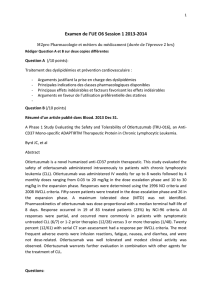
![Suggested translation[1] He learned[2] to dress tastefully. He moved](http://s1.studylibfr.com/store/data/005385129_1-269daba301ff059de68303e1bc025887-300x300.png)
